Will Pfeifer's Blog, page 9
December 3, 2017
Movies I Watched in October, Part 3
It's already December (!) so I figure I'd better finish the recap for October (!). Hang onto your hats, gang -- this one's going to be quick!
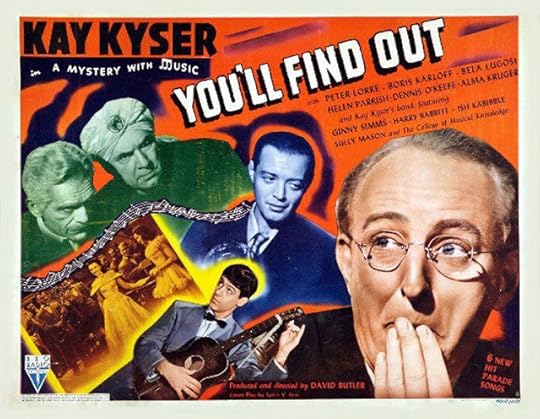
This movie was on the same Bela Lugosi/Boris Karloff set that included Bela's oddball semi-sequel to "I Walked with A Zombie" (read the write-up here). This musical comedy, dating from 1940, isn't quite as strange, but it is just as oddly enjoyable. Though it co-stars both Bela and Boris (plus Peter Lorre), it's really a vehicle for once-huge-now-forgotten bandleader and radio star Kay Kyser. The plot is your standard "weekend in a mansion with a killer on the loose," but there are plenty of fun elements to liven things up, including Lugosi as a fake medium, Karloff and Lorre as badguys pretending to be good guys, Kay Kyser's amusing dated comedy (and admittedly entertaining music) and plenty of secret passages, trap doors and hidden chambers. (Old movie fans will want to keep an eye out for the scene in the basement lab, where models from the original "King Kong" are used as set decorations -- including some insects from the famously deleted scene.) I say this about a lot of movies I watch, but they really don't make 'em like this anymore. That's a damned shame.
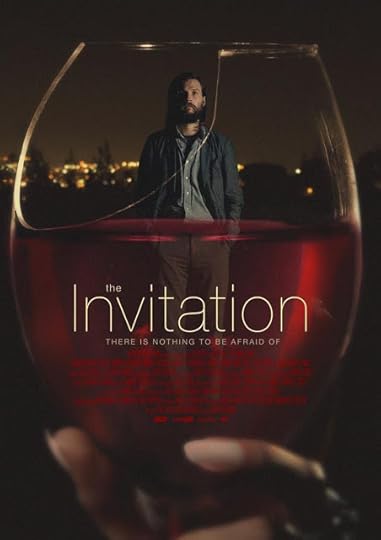
I'd heard good things regarding this drama/thriller about a couple who attend a dinner party in Los Angeles only to discover that it's all (probably) a set-up to get them to join some sort of cult. It's not bad, exactly, but it just didn't have that building intensity I was looking for, and the solid cast -- including the great John Carroll Lynch -- wasn't given much interesting to do. It ends in a surprisingly violent manner that hints at some sort of apocalyptic development, but "The Invitation" never felt like it got there in any sensible way, and instead kept upping the stakes (and the violence) whenever the movie needed a jolt of energy.
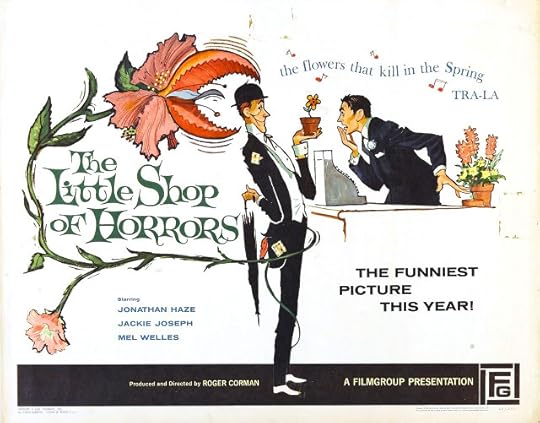
I've seen this Roger Corman comedy more times than I can count, starting on "Big Chuck and Little John," the Friday night monster movie show I watched as a kid, and continuing to the current day, when I try to catch it every time it airs on TCM. And though I've always loved it, I don't think I realized just how truly great a comedy it was until this most recent viewing. If you know anything about this movie, you probably know it was produced for virtually no movie in just a few days, and you've probably seen the big budget musical remake. I'm here to tell you that none of that matters. Sure, "Little Shop of Horrors" was cheaply made and looks it, but that aesthetic perfectly fits this tale of a schhlemiel who works in a Skid Row flower shop and accidentally breeds a carnivorous plant. And though the musical is a lot of fun, for my money it's not nearly as witty as this original model, which manages to include at least a half-dozen memorable supporting characters, that famous trip to the dentist where a young Jack Nicholson plays a masochist who gleefully reads PAIN magazine, one of the most memorable movie monsters since the Universal glory days, a dead-on "Dragnet" parody (complete with door knock that mimics the "Dragnet" theme song) and sequences of truly fascinating vintage late-night Los Angeles cinematography. Plus, giving credit where credit is due, as florist Gravis Mushnick, Mel Welles gives one of my favorite comedic performances, making with the Yiddish wisecracks and endless malapropisms. It's a truly great film, deserving a spot on the all-time great comedies. If you've never seen it, by all means check it out -- as a bonus, it accomplishes all that in a mere 72 minutes.

This movie was on the same Bela Lugosi/Boris Karloff set that included Bela's oddball semi-sequel to "I Walked with A Zombie" (read the write-up here). This musical comedy, dating from 1940, isn't quite as strange, but it is just as oddly enjoyable. Though it co-stars both Bela and Boris (plus Peter Lorre), it's really a vehicle for once-huge-now-forgotten bandleader and radio star Kay Kyser. The plot is your standard "weekend in a mansion with a killer on the loose," but there are plenty of fun elements to liven things up, including Lugosi as a fake medium, Karloff and Lorre as badguys pretending to be good guys, Kay Kyser's amusing dated comedy (and admittedly entertaining music) and plenty of secret passages, trap doors and hidden chambers. (Old movie fans will want to keep an eye out for the scene in the basement lab, where models from the original "King Kong" are used as set decorations -- including some insects from the famously deleted scene.) I say this about a lot of movies I watch, but they really don't make 'em like this anymore. That's a damned shame.

I'd heard good things regarding this drama/thriller about a couple who attend a dinner party in Los Angeles only to discover that it's all (probably) a set-up to get them to join some sort of cult. It's not bad, exactly, but it just didn't have that building intensity I was looking for, and the solid cast -- including the great John Carroll Lynch -- wasn't given much interesting to do. It ends in a surprisingly violent manner that hints at some sort of apocalyptic development, but "The Invitation" never felt like it got there in any sensible way, and instead kept upping the stakes (and the violence) whenever the movie needed a jolt of energy.

I've seen this Roger Corman comedy more times than I can count, starting on "Big Chuck and Little John," the Friday night monster movie show I watched as a kid, and continuing to the current day, when I try to catch it every time it airs on TCM. And though I've always loved it, I don't think I realized just how truly great a comedy it was until this most recent viewing. If you know anything about this movie, you probably know it was produced for virtually no movie in just a few days, and you've probably seen the big budget musical remake. I'm here to tell you that none of that matters. Sure, "Little Shop of Horrors" was cheaply made and looks it, but that aesthetic perfectly fits this tale of a schhlemiel who works in a Skid Row flower shop and accidentally breeds a carnivorous plant. And though the musical is a lot of fun, for my money it's not nearly as witty as this original model, which manages to include at least a half-dozen memorable supporting characters, that famous trip to the dentist where a young Jack Nicholson plays a masochist who gleefully reads PAIN magazine, one of the most memorable movie monsters since the Universal glory days, a dead-on "Dragnet" parody (complete with door knock that mimics the "Dragnet" theme song) and sequences of truly fascinating vintage late-night Los Angeles cinematography. Plus, giving credit where credit is due, as florist Gravis Mushnick, Mel Welles gives one of my favorite comedic performances, making with the Yiddish wisecracks and endless malapropisms. It's a truly great film, deserving a spot on the all-time great comedies. If you've never seen it, by all means check it out -- as a bonus, it accomplishes all that in a mere 72 minutes.
Published on December 03, 2017 16:51
November 21, 2017
Buy My Comics, Make Me Rich: The Librarians #2
The second issue of The Librarians arrives in stores Wednesday, Nov. 22, continuing the story of our intrepid, knowledge-seeking investigators and their adventures with schlock movie king Sol Schick. Here's the cover, courtesy of Karl Moline. There's also a variant cover featuring the character Cassandra Cillian (as portrayed by Lindy Booth).
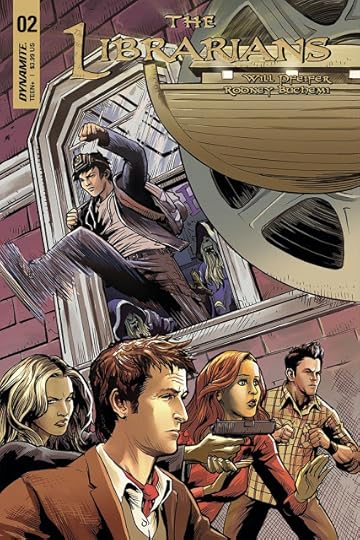
As before, script is by me and the art is by Rodney Buchemi, who really knocks it out of the park. No kidding -- I gave him some crazy stuff to draw, and he took every goofball concept I threw at him and really ran with them. This guy is the real deal.
You can read a preview of it here , and if you like what you see (and really, why wouldn't you?) you can also buy a copy of the issue at that very same link. Or support a local business and stop by your comic book shop to grab a copy of your own.

As before, script is by me and the art is by Rodney Buchemi, who really knocks it out of the park. No kidding -- I gave him some crazy stuff to draw, and he took every goofball concept I threw at him and really ran with them. This guy is the real deal.
You can read a preview of it here , and if you like what you see (and really, why wouldn't you?) you can also buy a copy of the issue at that very same link. Or support a local business and stop by your comic book shop to grab a copy of your own.
Published on November 21, 2017 15:14
November 15, 2017
Movies I Watched in October, Part 2
Part two of the October Movie Watching trilogy...
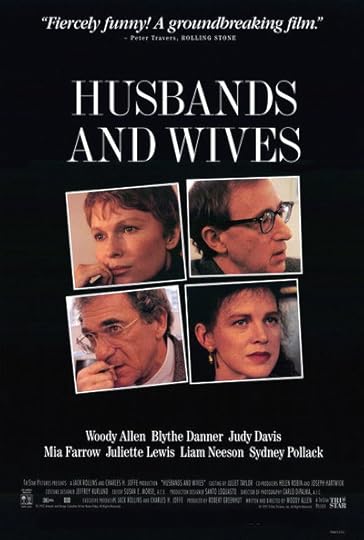
It feels a little strange to be writing about a Woody Allen movie – and arguably his most controversial one – in the sociopolitical current climate, but hey, I watch what I watch and I write what I write. This is probably Allen's last really solid movie following his outstanding 1980s run (including “Stardust Memories,” “Zelig,” “Broadway Danny Rose,” “Purple Rose of Cairo,” “Hannah and Her Sisters,” “Radio Days” and “Crimes and Misdemeanors”) and it’s an especially interesting film to watch now. For one thing, when "Husbands and Wives" was released in 1992, it was right after the news that Allen had been having an affair with Mia Farrow’s adopted daughter broke, which gave the divorce plot of “Husbands and Wives” a whole other level to be dissected. Because of that, the movie probably wasn’t appreciated for what it actually was, a well-made, small scale drama about how relationships live, die and (sometimes, though not always) bring themselves back to life. Allen and Farrow (in her last film with him – wonder why?) play a typical rich, intellectual New York couple stunned to hear their best friends (Sydney Pollack and Judy Davis) are splitting up. This leads them to question their own marriage, and it leads all of them to pursue (or at least consider pursuing) relationships with other rich, intellectual New Yorkers, including a post-“Darkman,” pre-“Schindler” Liam Neeson and a post-“Cape Fear,” pre-“Natural Born Killers” Juliette Lewis. Allen’s flirtation with Lewis is the most, er, problematic thing about the movie, partly because it seems so forced, and partly because, though Lewis is implied to be a few years older than Mariel Hemingway was in Manhattan, Allen is 13 years older and, frankly, looks it. On the other hand, Pollack and Davis are the best things about the movie, delivering energetic and angry performances that feel a lot more lively than Allen and Farrow. (I can't stress how much I like Pollack as an actor -- in this, "Tootsie," "Michael Clayton," "Eyes Wide Shut," you name it.) By the end of the movie, you barely care about Allen and Farrow’s relationship and whether it does or doesn’t survive, but you do care about Pollack and Davis – the whole movie should’ve been about them. One more thing that struck me about this movie, and about a lot of Woody Allen movies, come to think of it: Though he’s praised for his characters and dialogue (and he’s done great work with both, don’t get me wrong), watching “Husbands and Wives” it hit me that, for most of the movie, I didn’t believe these characters as actual people. It started to drive me crazy when they’d drop the name of some author or say something like “I have tickets to the opera” – it just didn’t feel anything like how actual people – even actual rich, intellectual New York people – act. It all felt, frankly, like placeholder dialogue that was designed to be replaced by something sharper and better. Maybe that’s why people prefer Woody Allen’s earlier, funnier movies – because they actually had some work put into them, including more than one draft of a script. I still like many of Allen’s films, including this one, but it’s easy to see why – scandals and controversy aside – many people don’t.
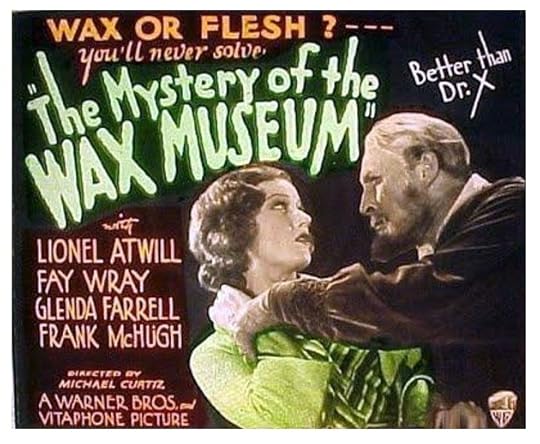 I love the Universal horror movies with their indeterminate, quasi-European settings and hard-to-pin-down time periods, but there’s something wonderfully weird about the few horror movies Warner Bros. produced in the early 1930s. That's mostly because they attempted to add the elements the studio was known for – newsroom settings, modern crimes and fast-talking dames – to lurid, even gruesome, horror elements. Even better, two of them – “Doctor X” and “Mystery of the Wax Museum” – were filmed using the two-strip technicolor process, giving them a dreamlike look that only adds to their oddball charm. TCM (who else?) included “Mystery of the Wax Museum” in its Halloween programming, so I made sure to catch it in its entirety, and wow, was I not disappointed. Glenda Farrell stars as a tough-talking reporter looking for a big scoop, and she figures she’s stumbled onto something involving the wax museum that opened on New Year’s Day. It’s owner and artistic director, played by the always welcome (and always creepy) Lionel Atwill, was horribly burned by gangsters years ago, and now he splits his time between plotting revenge and obsessing over his wax figure of Marie Antoinette. Enter Fay Wray, who is (Coincidentally? Naturally?) the spitting image of Marie, and from there things go deliciously insane. All the elements – the strange colors, the 1930s sensibilities, the dark humor and the even darker horror – add up to a movie that’s rarely actually scary but also never not fun. Keep an eye out during the scenes set in the wax museum – wax figures would’ve melted under the insanely hot studio lights required for two-strip color, so those are human extras trying (and often failing) to remain perfectly still.
I love the Universal horror movies with their indeterminate, quasi-European settings and hard-to-pin-down time periods, but there’s something wonderfully weird about the few horror movies Warner Bros. produced in the early 1930s. That's mostly because they attempted to add the elements the studio was known for – newsroom settings, modern crimes and fast-talking dames – to lurid, even gruesome, horror elements. Even better, two of them – “Doctor X” and “Mystery of the Wax Museum” – were filmed using the two-strip technicolor process, giving them a dreamlike look that only adds to their oddball charm. TCM (who else?) included “Mystery of the Wax Museum” in its Halloween programming, so I made sure to catch it in its entirety, and wow, was I not disappointed. Glenda Farrell stars as a tough-talking reporter looking for a big scoop, and she figures she’s stumbled onto something involving the wax museum that opened on New Year’s Day. It’s owner and artistic director, played by the always welcome (and always creepy) Lionel Atwill, was horribly burned by gangsters years ago, and now he splits his time between plotting revenge and obsessing over his wax figure of Marie Antoinette. Enter Fay Wray, who is (Coincidentally? Naturally?) the spitting image of Marie, and from there things go deliciously insane. All the elements – the strange colors, the 1930s sensibilities, the dark humor and the even darker horror – add up to a movie that’s rarely actually scary but also never not fun. Keep an eye out during the scenes set in the wax museum – wax figures would’ve melted under the insanely hot studio lights required for two-strip color, so those are human extras trying (and often failing) to remain perfectly still.
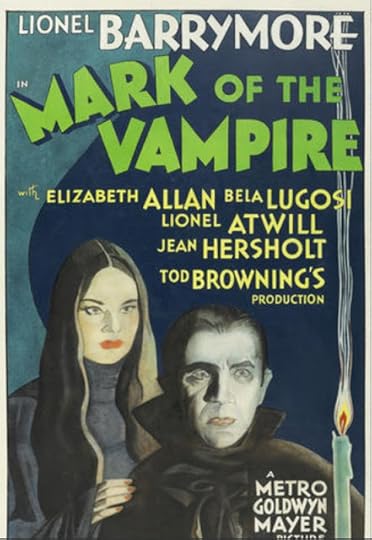
And, proving that not every horror made in the 1930s was a classic, we come to “Mark of the Vampire,” a 1935 film that I’ve read about in dozens of books (the photos of Carroll Borland are downright iconic) but somehow managed to never see, despite the fact that I’ve owned a nice DVD copy for more than a decade. It’s a semi-remake of the 1927 Lon Chaney movie “London After Midnight,” also directed by Tod Browning. I’ve never seen that one either (it’s considered lost and only exists as a series of stills), but part of the problem of “Vampire” lies in its roots to that earlier film. Quick history lesson: Before Browning’s “Dracula” hit theaters in 1931, virtually every American horror movie cheated on the actual “horror” by revealing supposedly supernatural events to be hoaxes perpetrated to achieve some far-fetched goal (often involving an inheritance). One reason “Dracula” and “Frankenstein” had such a seismic impact was they deal with actual monsters. That’s why “Mark of the Vampire” is so frustrating (spoilers coming up for an 82-year-old film): The convoluted, creaky plot involving Lugosi and Borland supposedly being vampires is revealed to be nothing but a scam -- they’re really a couple of stage actors hired to trick the real murderer into confessing his crime. It feels like a cheat (because it is one), and what’s more, it wastes the skills of Lugosi (who gets just one line of dialogue at the end of the film) and Borland (who, like I said, is an iconic vision that launched a million goth girls). Browning’s direction, as per usual for his later works, is creaky and stagy, but legendary cinematographer James Wong Howe does manage to give the movie an ominous, shadowy style that, like the other intriguing elements, winds up being wasted. If you’re bound and determined to watch ever last 1930s horror film (like I was), I suppose you should check this out – but don’t say I didn’t warn you.
Up next: More Lugosi -- in a pair of offbeat RKO comedies -- plus possibly the greatest horror comedy ever made (at least in this guy's opinion)

It feels a little strange to be writing about a Woody Allen movie – and arguably his most controversial one – in the sociopolitical current climate, but hey, I watch what I watch and I write what I write. This is probably Allen's last really solid movie following his outstanding 1980s run (including “Stardust Memories,” “Zelig,” “Broadway Danny Rose,” “Purple Rose of Cairo,” “Hannah and Her Sisters,” “Radio Days” and “Crimes and Misdemeanors”) and it’s an especially interesting film to watch now. For one thing, when "Husbands and Wives" was released in 1992, it was right after the news that Allen had been having an affair with Mia Farrow’s adopted daughter broke, which gave the divorce plot of “Husbands and Wives” a whole other level to be dissected. Because of that, the movie probably wasn’t appreciated for what it actually was, a well-made, small scale drama about how relationships live, die and (sometimes, though not always) bring themselves back to life. Allen and Farrow (in her last film with him – wonder why?) play a typical rich, intellectual New York couple stunned to hear their best friends (Sydney Pollack and Judy Davis) are splitting up. This leads them to question their own marriage, and it leads all of them to pursue (or at least consider pursuing) relationships with other rich, intellectual New Yorkers, including a post-“Darkman,” pre-“Schindler” Liam Neeson and a post-“Cape Fear,” pre-“Natural Born Killers” Juliette Lewis. Allen’s flirtation with Lewis is the most, er, problematic thing about the movie, partly because it seems so forced, and partly because, though Lewis is implied to be a few years older than Mariel Hemingway was in Manhattan, Allen is 13 years older and, frankly, looks it. On the other hand, Pollack and Davis are the best things about the movie, delivering energetic and angry performances that feel a lot more lively than Allen and Farrow. (I can't stress how much I like Pollack as an actor -- in this, "Tootsie," "Michael Clayton," "Eyes Wide Shut," you name it.) By the end of the movie, you barely care about Allen and Farrow’s relationship and whether it does or doesn’t survive, but you do care about Pollack and Davis – the whole movie should’ve been about them. One more thing that struck me about this movie, and about a lot of Woody Allen movies, come to think of it: Though he’s praised for his characters and dialogue (and he’s done great work with both, don’t get me wrong), watching “Husbands and Wives” it hit me that, for most of the movie, I didn’t believe these characters as actual people. It started to drive me crazy when they’d drop the name of some author or say something like “I have tickets to the opera” – it just didn’t feel anything like how actual people – even actual rich, intellectual New York people – act. It all felt, frankly, like placeholder dialogue that was designed to be replaced by something sharper and better. Maybe that’s why people prefer Woody Allen’s earlier, funnier movies – because they actually had some work put into them, including more than one draft of a script. I still like many of Allen’s films, including this one, but it’s easy to see why – scandals and controversy aside – many people don’t.
 I love the Universal horror movies with their indeterminate, quasi-European settings and hard-to-pin-down time periods, but there’s something wonderfully weird about the few horror movies Warner Bros. produced in the early 1930s. That's mostly because they attempted to add the elements the studio was known for – newsroom settings, modern crimes and fast-talking dames – to lurid, even gruesome, horror elements. Even better, two of them – “Doctor X” and “Mystery of the Wax Museum” – were filmed using the two-strip technicolor process, giving them a dreamlike look that only adds to their oddball charm. TCM (who else?) included “Mystery of the Wax Museum” in its Halloween programming, so I made sure to catch it in its entirety, and wow, was I not disappointed. Glenda Farrell stars as a tough-talking reporter looking for a big scoop, and she figures she’s stumbled onto something involving the wax museum that opened on New Year’s Day. It’s owner and artistic director, played by the always welcome (and always creepy) Lionel Atwill, was horribly burned by gangsters years ago, and now he splits his time between plotting revenge and obsessing over his wax figure of Marie Antoinette. Enter Fay Wray, who is (Coincidentally? Naturally?) the spitting image of Marie, and from there things go deliciously insane. All the elements – the strange colors, the 1930s sensibilities, the dark humor and the even darker horror – add up to a movie that’s rarely actually scary but also never not fun. Keep an eye out during the scenes set in the wax museum – wax figures would’ve melted under the insanely hot studio lights required for two-strip color, so those are human extras trying (and often failing) to remain perfectly still.
I love the Universal horror movies with their indeterminate, quasi-European settings and hard-to-pin-down time periods, but there’s something wonderfully weird about the few horror movies Warner Bros. produced in the early 1930s. That's mostly because they attempted to add the elements the studio was known for – newsroom settings, modern crimes and fast-talking dames – to lurid, even gruesome, horror elements. Even better, two of them – “Doctor X” and “Mystery of the Wax Museum” – were filmed using the two-strip technicolor process, giving them a dreamlike look that only adds to their oddball charm. TCM (who else?) included “Mystery of the Wax Museum” in its Halloween programming, so I made sure to catch it in its entirety, and wow, was I not disappointed. Glenda Farrell stars as a tough-talking reporter looking for a big scoop, and she figures she’s stumbled onto something involving the wax museum that opened on New Year’s Day. It’s owner and artistic director, played by the always welcome (and always creepy) Lionel Atwill, was horribly burned by gangsters years ago, and now he splits his time between plotting revenge and obsessing over his wax figure of Marie Antoinette. Enter Fay Wray, who is (Coincidentally? Naturally?) the spitting image of Marie, and from there things go deliciously insane. All the elements – the strange colors, the 1930s sensibilities, the dark humor and the even darker horror – add up to a movie that’s rarely actually scary but also never not fun. Keep an eye out during the scenes set in the wax museum – wax figures would’ve melted under the insanely hot studio lights required for two-strip color, so those are human extras trying (and often failing) to remain perfectly still.
And, proving that not every horror made in the 1930s was a classic, we come to “Mark of the Vampire,” a 1935 film that I’ve read about in dozens of books (the photos of Carroll Borland are downright iconic) but somehow managed to never see, despite the fact that I’ve owned a nice DVD copy for more than a decade. It’s a semi-remake of the 1927 Lon Chaney movie “London After Midnight,” also directed by Tod Browning. I’ve never seen that one either (it’s considered lost and only exists as a series of stills), but part of the problem of “Vampire” lies in its roots to that earlier film. Quick history lesson: Before Browning’s “Dracula” hit theaters in 1931, virtually every American horror movie cheated on the actual “horror” by revealing supposedly supernatural events to be hoaxes perpetrated to achieve some far-fetched goal (often involving an inheritance). One reason “Dracula” and “Frankenstein” had such a seismic impact was they deal with actual monsters. That’s why “Mark of the Vampire” is so frustrating (spoilers coming up for an 82-year-old film): The convoluted, creaky plot involving Lugosi and Borland supposedly being vampires is revealed to be nothing but a scam -- they’re really a couple of stage actors hired to trick the real murderer into confessing his crime. It feels like a cheat (because it is one), and what’s more, it wastes the skills of Lugosi (who gets just one line of dialogue at the end of the film) and Borland (who, like I said, is an iconic vision that launched a million goth girls). Browning’s direction, as per usual for his later works, is creaky and stagy, but legendary cinematographer James Wong Howe does manage to give the movie an ominous, shadowy style that, like the other intriguing elements, winds up being wasted. If you’re bound and determined to watch ever last 1930s horror film (like I was), I suppose you should check this out – but don’t say I didn’t warn you.
Up next: More Lugosi -- in a pair of offbeat RKO comedies -- plus possibly the greatest horror comedy ever made (at least in this guy's opinion)
Published on November 15, 2017 17:06
November 12, 2017
Movies I watched in October, Part 1
Started the movie month off with a big one -- one of the best I've seen all year, easily...
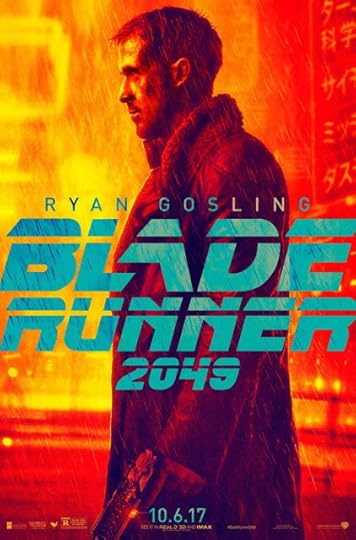
Frankly, as someone who saw the original "Blade Runner" in the theaters, I was more than a little skeptical about a sequel, especially since recent Harrison Ford sequels (I'm looking at you, "Kingdom of the Crystal Skull") had a decidedly mixed track record. But with the involvement of Ryan Gosling (an actor I really like) and -- especially -- with director Denis Villeneuve at the helm, I was guardedly optimistic. Turns out I was right to be, optimistic, that is -- "Blade Runner 2049" is a more than worthy sequel. It's visually jaw-dropping, emotionally powerful and just weird enough to deliver the same off-kilter vibe as the original. Roger Deakins had better (finally) win the cinematography Oscar this year, because I don't know when I've seen a more beautiful, more mesmerizing vision created on film. Same goes for production design Dennis Gassner and his team -- the term "world building" is more than a little overused these days, but "Blade Runner 2049" really does create a fully realized world, one that feels like it exists beyond the frame (and timeframe) of the movie. When I walked out of the theater I was in the sort of wonderful daze that a great movie puts me in, and even a month later, I still feel myself pulled back to Los Angeles circa 2049. If by some chance "Blade Runner 2049" is still playing in your local theater, go see it before it leaves -- this is one movie that demands to be experienced on the big screen.
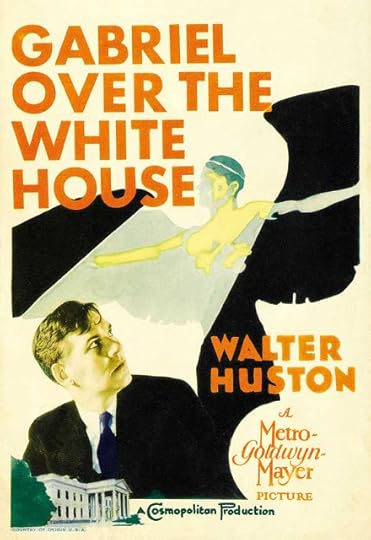
I've seen this oddball pre-Coder more than a few times, but I almost always watch at least part of it when it reruns on TCM, mostly because it's so damned strange -- and strangely entertaining. Walter Huston (an actor who I discovered via TCM and appreciate more each time I see him) plays a shallow political hack elected to the White House who, after a joy-riding car crash, either loses his mind or receives heavenly guidance (six of one...) and becomes a dynamic, go-getter, frankly fascist chief exec who stops crime, puts the nation to work and achieves world peace in a matter of months. Filmed before FDR took office in 1933, it must've been a sort of wish-fulfillment story aimed at a country praying the president would do something -- anything! -- to pull America out of its tailspin. Whether anyone would've wanted what happens in "Gabriel" is another matter, but it sure is entertaining watching Huston rally the homeless, execute mobsters and threaten the nations of the world with annihilation if they don't pay their debts. There's certainly never been a movie quite like it.
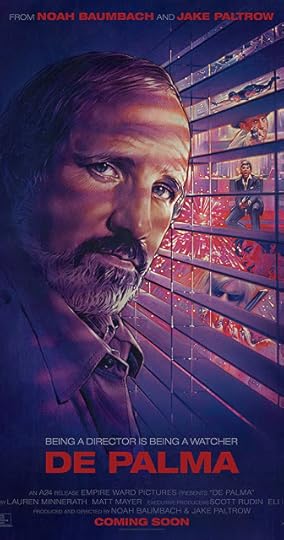
Though I've never been a huge De Palma fan, I find him a fascinating director because (a) he's been working since the 1960s and always brings his own sensibility to his films, (b) he's best known for suspense thrillers, but he's moved through several genres, and (c) he's a thoughtful guy who really knows movies, both his own and the work of others. For those reasons (and a few others, namely his films themselves), he's the perfect guy for this sort of documentary, which is a film-by-film conversational retrospective of his entire career. De Palma goes through all his movies in order (with the offscreen help of directors Jake Paltrow and Noah Baumbach) offering insights, behind-the-scenes stories and occasional bits of very entertaining dirt. (On "Obsession," for instance, co-star Cliff Robertson self-tanned so much that cinematographer Vilmos Zsigmond yelled that he was the same color as the wood-paneling background and thus, very tough to light correctly.) I read some reviews of "De Palma" that complained the film gave space to DePalma's lesser known, later movies, but truth is, those are some of the most interesting parts, hearing a career director discuss his own career valleys. Watching this actually made me want to rewatch several DePalma movies, and I suppose that's the best review a doc like this can get.
Coming up: Controversial Woody Allen, a two-color horror movie and Bela Lugosi's other vampire movie...

Frankly, as someone who saw the original "Blade Runner" in the theaters, I was more than a little skeptical about a sequel, especially since recent Harrison Ford sequels (I'm looking at you, "Kingdom of the Crystal Skull") had a decidedly mixed track record. But with the involvement of Ryan Gosling (an actor I really like) and -- especially -- with director Denis Villeneuve at the helm, I was guardedly optimistic. Turns out I was right to be, optimistic, that is -- "Blade Runner 2049" is a more than worthy sequel. It's visually jaw-dropping, emotionally powerful and just weird enough to deliver the same off-kilter vibe as the original. Roger Deakins had better (finally) win the cinematography Oscar this year, because I don't know when I've seen a more beautiful, more mesmerizing vision created on film. Same goes for production design Dennis Gassner and his team -- the term "world building" is more than a little overused these days, but "Blade Runner 2049" really does create a fully realized world, one that feels like it exists beyond the frame (and timeframe) of the movie. When I walked out of the theater I was in the sort of wonderful daze that a great movie puts me in, and even a month later, I still feel myself pulled back to Los Angeles circa 2049. If by some chance "Blade Runner 2049" is still playing in your local theater, go see it before it leaves -- this is one movie that demands to be experienced on the big screen.

I've seen this oddball pre-Coder more than a few times, but I almost always watch at least part of it when it reruns on TCM, mostly because it's so damned strange -- and strangely entertaining. Walter Huston (an actor who I discovered via TCM and appreciate more each time I see him) plays a shallow political hack elected to the White House who, after a joy-riding car crash, either loses his mind or receives heavenly guidance (six of one...) and becomes a dynamic, go-getter, frankly fascist chief exec who stops crime, puts the nation to work and achieves world peace in a matter of months. Filmed before FDR took office in 1933, it must've been a sort of wish-fulfillment story aimed at a country praying the president would do something -- anything! -- to pull America out of its tailspin. Whether anyone would've wanted what happens in "Gabriel" is another matter, but it sure is entertaining watching Huston rally the homeless, execute mobsters and threaten the nations of the world with annihilation if they don't pay their debts. There's certainly never been a movie quite like it.

Though I've never been a huge De Palma fan, I find him a fascinating director because (a) he's been working since the 1960s and always brings his own sensibility to his films, (b) he's best known for suspense thrillers, but he's moved through several genres, and (c) he's a thoughtful guy who really knows movies, both his own and the work of others. For those reasons (and a few others, namely his films themselves), he's the perfect guy for this sort of documentary, which is a film-by-film conversational retrospective of his entire career. De Palma goes through all his movies in order (with the offscreen help of directors Jake Paltrow and Noah Baumbach) offering insights, behind-the-scenes stories and occasional bits of very entertaining dirt. (On "Obsession," for instance, co-star Cliff Robertson self-tanned so much that cinematographer Vilmos Zsigmond yelled that he was the same color as the wood-paneling background and thus, very tough to light correctly.) I read some reviews of "De Palma" that complained the film gave space to DePalma's lesser known, later movies, but truth is, those are some of the most interesting parts, hearing a career director discuss his own career valleys. Watching this actually made me want to rewatch several DePalma movies, and I suppose that's the best review a doc like this can get.
Coming up: Controversial Woody Allen, a two-color horror movie and Bela Lugosi's other vampire movie...
Published on November 12, 2017 12:23
October 29, 2017
Movies I Watched in September, Part 3
Winding up the month of September on this blog as the month of October winds up in the real world.
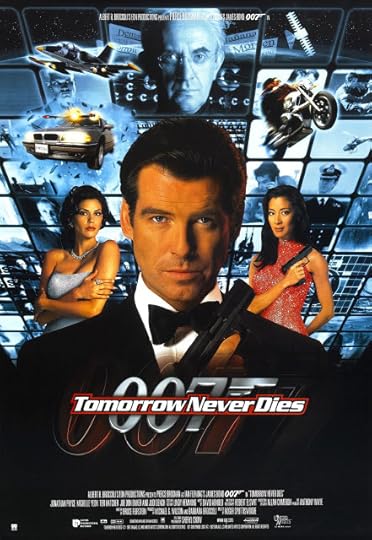
Watched this Pierce Brosnan Bond flick to keep up with the (then) current episode of the (excellent) James Bonding podcast, and, like one of the co-hosts, I was sorely disappointed. It's definitely one of the worst Bond films, and not in a fun-filled manner like one of my (honestly) favorite (but not objectively) good Bond movies, "Diamonds Are Forever." (Got all that?) "Tomorrow Never Dies" admittedly has some promising elements, including a media mogul villain played by Jonathan Pryce and a Chinese secret agent played by Michelle Yeoh. But the movie never finds its footing, and the media elements seem embarrassing naive even in 1997, with Pryce boasting about his magazines, TV channels and newspapers, but missing out on a certain media revolution that was even then taking place. (Here's a hint -- you're using it right now.) My advice? Skip the movie, but listen to the podcast -- unlike the film, it's genuinely entertaining.
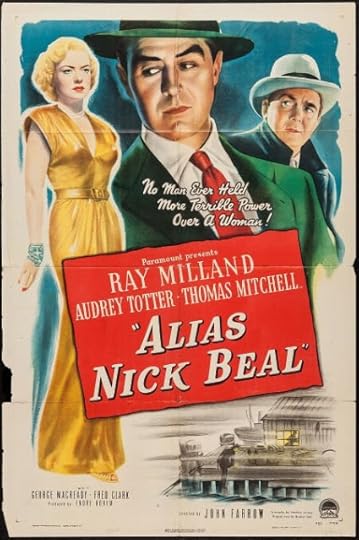
Caught this 1949 drama on TCM, partly because noir expert Eddie Muller mentioned that this would be a rare chance to catch it, and plus, I always enjoy (a) noir films (b) movies with a devil character (b) Ray Milland and (d) noir femme fatale Audrey Totter. I just wish I'd enjoyed the movie itself more. It's not bad by any means (it's certainly not "Tomorrow Never Dies"), but with all those intriguing factors in its favor, I found the end result a little, well, dull. The story involves a straight-arrow D.A. (Thomas Mitchell, aka Uncle Billy from "It's a Wonderful Life") who slowly but surely sells his soul to the devil (Milland's Nick Beal) for political gain. The leads are solid and George Macready, who usually plays a weasel, is on the side of the angels this time as the minister who sets Mitchell straight. Still, for some reason, it just didn't connect with me. I much prefer the previous year's team effort with Milland, Macready and director John Farrow, "The Big Clock." Now that, my friends, is a movie!
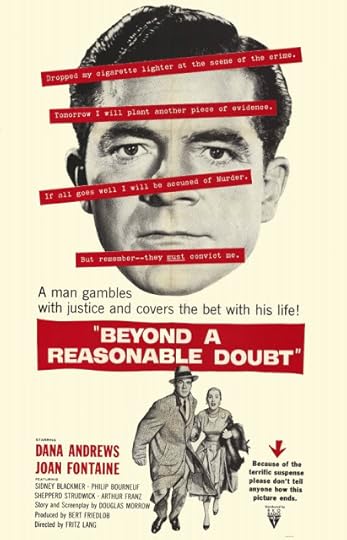
Having spent more than two decades slogging it out in a newsroom, I'm a sucker for newspaper movies, especially vintage black-and-white ones set in vintage hard-boiled newsrooms. One of my favorites is "When the City Sleeps," a Fritz Lang-directed film starring Dana Andrews. So, naturally, I figured this one, from the same year and with the same star and director, would be right up my alley. And, well .... (do you sense a theme developing in this blog post?) The premise is compelling, if a bit far-fetched: A reporter/novelist (Andrews) conspires with his publisher and future father-in-law (Sidney Blackmer) to frame himself for a murder using only circumstantial evidence, then reveal the truth after the conviction and thus, deal a fatal blow to the concept of capital punishment. Naturally, things do not go as planned, and even more naturally, there's a third act twist that, frankly, I should've seen coming. It's not nearly as entertaining as "When the City Sleeps," I'm sad to say, and Dana Andrews sleepwalks through what, on paper at least, is a pretty meaty role. Still, at least you get Blackmer (best known as Roman Castevet in "Rosemary's Baby") as the publisher and Barbara Nichols (from "Sweet Smell of Success") as a stripper. So it's not a total loss. And that's a nice poster, right?
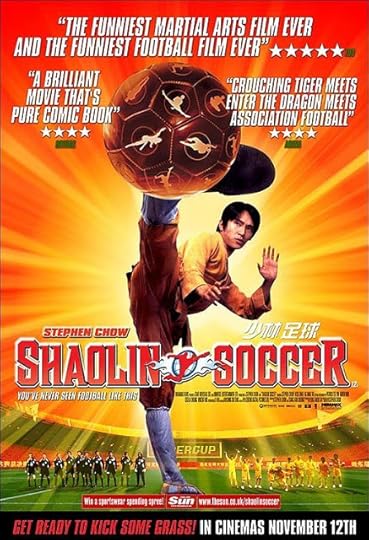
Mom was out of the house, so for a daddy-daughter night, Allie and I decided to watch this Stephen Chow action comedy, being that we're both big fans of his 2004 movie "Kung Fu Hustle." "Shaolin Soccer," which came first, isn't quite on that level, but it's an entertaining way to spend 113 or so minutes. Chow plays a Shaolin student trying to teach his kung fu who runs into a disgraced soccer player looking for one last shot at redemption. Eventually, Chow and the player gather (what else?) a ragtag bunch of bums, each with a hidden super-power that comes in suspiciously handy on the soccer field. It's all played very, very broadly, even compared with the cartoonish concepts of "Kung Fu Hustle" (for one thing, the evil team is actually named "Team Evil"), but that only adds to the fun, and though you can predict the ending a mile away, it's still a blast to see the crazy ways the movie gets there. Allie's favorite part? When Chow's chubby brother can't resist food, to the point where he eats broken eggs (a) off someone's foot and (b) out of someone's mouth. I told you it was broad comedy.

Watched this Pierce Brosnan Bond flick to keep up with the (then) current episode of the (excellent) James Bonding podcast, and, like one of the co-hosts, I was sorely disappointed. It's definitely one of the worst Bond films, and not in a fun-filled manner like one of my (honestly) favorite (but not objectively) good Bond movies, "Diamonds Are Forever." (Got all that?) "Tomorrow Never Dies" admittedly has some promising elements, including a media mogul villain played by Jonathan Pryce and a Chinese secret agent played by Michelle Yeoh. But the movie never finds its footing, and the media elements seem embarrassing naive even in 1997, with Pryce boasting about his magazines, TV channels and newspapers, but missing out on a certain media revolution that was even then taking place. (Here's a hint -- you're using it right now.) My advice? Skip the movie, but listen to the podcast -- unlike the film, it's genuinely entertaining.

Caught this 1949 drama on TCM, partly because noir expert Eddie Muller mentioned that this would be a rare chance to catch it, and plus, I always enjoy (a) noir films (b) movies with a devil character (b) Ray Milland and (d) noir femme fatale Audrey Totter. I just wish I'd enjoyed the movie itself more. It's not bad by any means (it's certainly not "Tomorrow Never Dies"), but with all those intriguing factors in its favor, I found the end result a little, well, dull. The story involves a straight-arrow D.A. (Thomas Mitchell, aka Uncle Billy from "It's a Wonderful Life") who slowly but surely sells his soul to the devil (Milland's Nick Beal) for political gain. The leads are solid and George Macready, who usually plays a weasel, is on the side of the angels this time as the minister who sets Mitchell straight. Still, for some reason, it just didn't connect with me. I much prefer the previous year's team effort with Milland, Macready and director John Farrow, "The Big Clock." Now that, my friends, is a movie!

Having spent more than two decades slogging it out in a newsroom, I'm a sucker for newspaper movies, especially vintage black-and-white ones set in vintage hard-boiled newsrooms. One of my favorites is "When the City Sleeps," a Fritz Lang-directed film starring Dana Andrews. So, naturally, I figured this one, from the same year and with the same star and director, would be right up my alley. And, well .... (do you sense a theme developing in this blog post?) The premise is compelling, if a bit far-fetched: A reporter/novelist (Andrews) conspires with his publisher and future father-in-law (Sidney Blackmer) to frame himself for a murder using only circumstantial evidence, then reveal the truth after the conviction and thus, deal a fatal blow to the concept of capital punishment. Naturally, things do not go as planned, and even more naturally, there's a third act twist that, frankly, I should've seen coming. It's not nearly as entertaining as "When the City Sleeps," I'm sad to say, and Dana Andrews sleepwalks through what, on paper at least, is a pretty meaty role. Still, at least you get Blackmer (best known as Roman Castevet in "Rosemary's Baby") as the publisher and Barbara Nichols (from "Sweet Smell of Success") as a stripper. So it's not a total loss. And that's a nice poster, right?

Mom was out of the house, so for a daddy-daughter night, Allie and I decided to watch this Stephen Chow action comedy, being that we're both big fans of his 2004 movie "Kung Fu Hustle." "Shaolin Soccer," which came first, isn't quite on that level, but it's an entertaining way to spend 113 or so minutes. Chow plays a Shaolin student trying to teach his kung fu who runs into a disgraced soccer player looking for one last shot at redemption. Eventually, Chow and the player gather (what else?) a ragtag bunch of bums, each with a hidden super-power that comes in suspiciously handy on the soccer field. It's all played very, very broadly, even compared with the cartoonish concepts of "Kung Fu Hustle" (for one thing, the evil team is actually named "Team Evil"), but that only adds to the fun, and though you can predict the ending a mile away, it's still a blast to see the crazy ways the movie gets there. Allie's favorite part? When Chow's chubby brother can't resist food, to the point where he eats broken eggs (a) off someone's foot and (b) out of someone's mouth. I told you it was broad comedy.
Published on October 29, 2017 13:49
October 23, 2017
Movies I Watched in September, Part 2
Part two of the September recap. Something for everyone in this installment, I'd say...
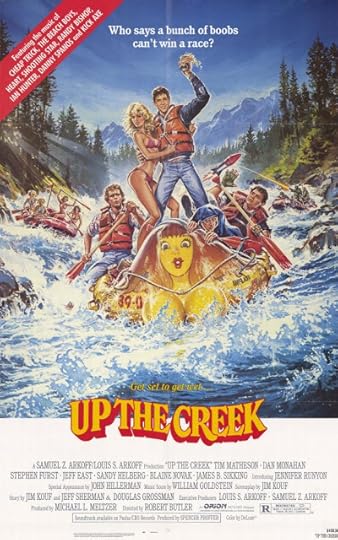
I live-tweeted my recent viewing of this goofy, good-natured 1984 snobs-versus-slobs comedy (which I originally saw as a teen), so how about I just use those tweets for the review (and please, feel free to follow me on Twitter ):
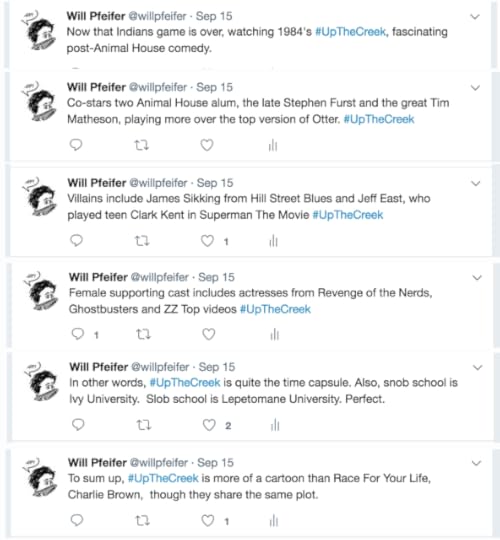
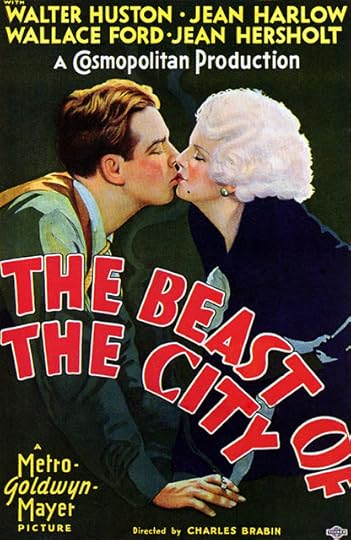
I’ve seen “The Beast of the City” more than a few times, but it’s one of the crazier pre-Code movies that runs in heavy rotation on TCM, so I figured I’d give it another go. I’m a sucker for Walter Huston, here playing a tough-as-nails police captain who arrests the local gang leader (played by Jean Hersholt, the guy they named the Oscar special award after). A corrupt judge frees the gangster, though, and poor straitlaced Walter is shuffled off to the suburbs in disgrace. But after catching two armed robbers, he returns in glory, becomes the chief, and leads the entire police force into Hersholt’s club, where everyone dies in a glorious hail of bullets. No kidding. Unlike the Warner Bros. movies of the same era (1932), this MGM effort focuses on the cops, not the criminals, mostly because MGM leaned far right while Warner Bros. tilted a little left. "Beast of the City" lacks a lot of the shading and, frankly, pizzazz, that made “The Public Enemy” and “Little Caesar” so entertaining, so it's not on the level of those classics. Huston’s great, don’t get me wrong, but otherwise all the movie has is a typically blah performance from Jean Harlow (sorry, Harlow fans), a nice weasel turn by Wallace Ford (who played the Phroso the Clown that same year in MGM’s “Freaks”) and an unbilled (and impossibly young) Mickey Rooney as Huston’s son. That ending, though, which is as brutal as just about any pre-Coder I've ever seen, makes the whole thing worth a look.
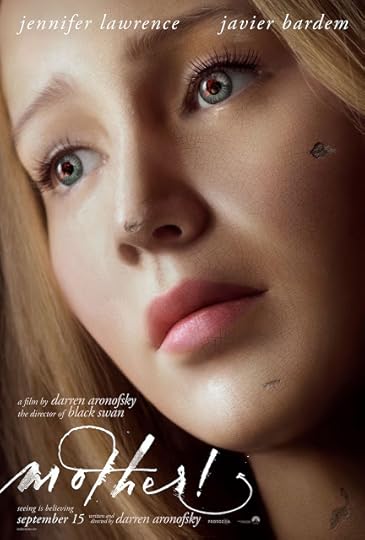
Amy and I had a free night, sans child, so we decided to catch a movie. And boy oh boy, am I glad we chose this one. I’m even more glad that we went in knowing virtually nothing, with only the trailer – which seemed to promise a sort of “Rosemary’s Baby”-type thriller – to guide us. It might not have been the best theatrical movie I’ve seen in a while, but it was definitely the most memorable, and after many months of seeing perfectly fine but not exactly taxing movies like “Spider-Man: Homecoming” and “Guardians of the Galaxy: Vol. 2” in the theater, it was a real pleasure to sit back, have the lights go down and experience a movie that genuinely pushed things as far as they could go, then pushed them a little farther. The last movie I saw where someone actually walked out of a movie was “Brokeback Mountain” way back in 2005, but “mother!” definitely provoked a few stunned stumblings toward the exit, and if you’ve seen the movie, you’ll probably be able to guess the scene. (No spoilers here.) Aronofsky’s film is definitely not a pleasant experience, and I’m still not quite sure how objectively good the movie is. But it’s absolutely effective, and if you’re looking for a movie that will put you through the wringer, I can’t think of a better one to recommend. The first half becomes almost unbearably tense and frustrating, but the second half takes things to an ever escalating series of crazy twists, where insane things happen that suddenly look relatively sane compared with what follows. I’ve seen a lot of strange movies in my life, but I can honestly say I’ve never seen anything quite like this. Too bad it died at the box office because this is one film best experience on the big screen – where you feel small and powerless in its presence. (By the way, the poster pictured above is pretty damned brilliant, especially when you (a) look closely and (b) know what the movie is really about.)
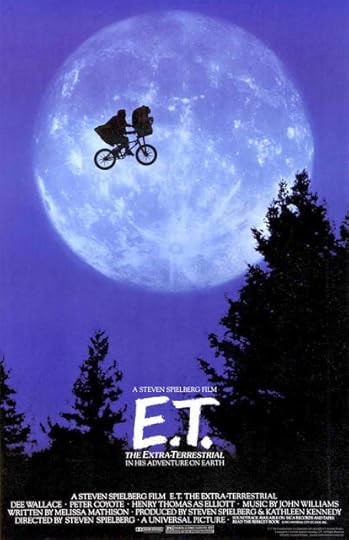
It’s good, of course. Really good, in fact, and you can see why, in the years between “Star Wars” and “Jurassic Park,” it was the most popular movie of all time. Amy, Allie and I saw it during its brief theatrical (re)run this fall, and it’s amazing how still well it works on the big screen. (We saw it the same weekend as “mother!,” in fact, and it’s hard to imagine a more extreme case of pop cultural whiplash.) One thing that struck me this time was how effectively the character of Michael, the older brother played by Robert McNaughton, is used. The movie is Elliot’s story, but unlike many lesser movies, Michael isn’t portrayed as a jerk or a bully. He’s a kid, too, amazed by what’s happening and, eventually, scared by what’s happening to his little brother and his little brother's alien friend. This, not the special effects or the Reese Piece’s or even the beautiful cinematography, is why “E.T.” succeeded where so many similar films failed: the characters, each and every one of them, feel like real people. And that includes the title character.
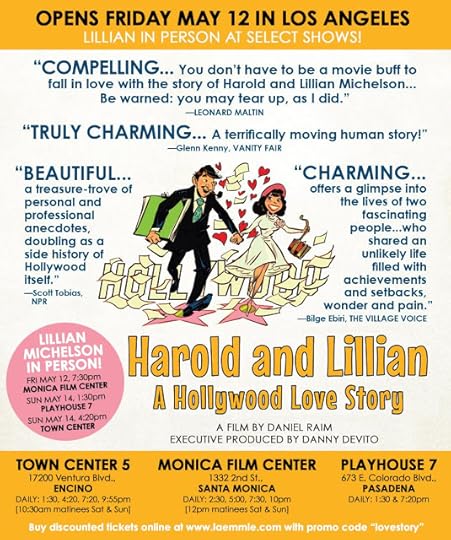
Low-key but interesting documentary about the lives of Harold and Lillian Michelson, two Hollywood stalwarts who managed to combine careers in the movie business with a 60-year marriage. Harold was a storyboard artist and production designer who worked on everything from "The Ten Commandments" to "The Graduate." (It was he, in fact, who conceived the shot where Mrs. Robinson's bent leg frames Benjamin -- you know, one of the most famous shots in movie history.) Lillian ran film research libraries for various studios while, at the same time, raising three children. (Her stories of struggling -- and succeeding -- to raise a son with autism in a time with little understanding or support of his condition are some of the most powerful segments in the film.) Together, they became virtual legends in the film community, and the film has comments from directors, producers and storyboard artists singing their praises. For movie fans, it'll be fascinating stuff, and even if you're not a die-hard film buff, you'll find their story entertaining. At the very least, it offers a peak into two behind-the-scenes jobs you might not have known existed.
Up next: The end of the September recap, including a pretty bad Bond, two forgotten old movies and possibly the craziest sports movie ever made.

I live-tweeted my recent viewing of this goofy, good-natured 1984 snobs-versus-slobs comedy (which I originally saw as a teen), so how about I just use those tweets for the review (and please, feel free to follow me on Twitter ):


I’ve seen “The Beast of the City” more than a few times, but it’s one of the crazier pre-Code movies that runs in heavy rotation on TCM, so I figured I’d give it another go. I’m a sucker for Walter Huston, here playing a tough-as-nails police captain who arrests the local gang leader (played by Jean Hersholt, the guy they named the Oscar special award after). A corrupt judge frees the gangster, though, and poor straitlaced Walter is shuffled off to the suburbs in disgrace. But after catching two armed robbers, he returns in glory, becomes the chief, and leads the entire police force into Hersholt’s club, where everyone dies in a glorious hail of bullets. No kidding. Unlike the Warner Bros. movies of the same era (1932), this MGM effort focuses on the cops, not the criminals, mostly because MGM leaned far right while Warner Bros. tilted a little left. "Beast of the City" lacks a lot of the shading and, frankly, pizzazz, that made “The Public Enemy” and “Little Caesar” so entertaining, so it's not on the level of those classics. Huston’s great, don’t get me wrong, but otherwise all the movie has is a typically blah performance from Jean Harlow (sorry, Harlow fans), a nice weasel turn by Wallace Ford (who played the Phroso the Clown that same year in MGM’s “Freaks”) and an unbilled (and impossibly young) Mickey Rooney as Huston’s son. That ending, though, which is as brutal as just about any pre-Coder I've ever seen, makes the whole thing worth a look.

Amy and I had a free night, sans child, so we decided to catch a movie. And boy oh boy, am I glad we chose this one. I’m even more glad that we went in knowing virtually nothing, with only the trailer – which seemed to promise a sort of “Rosemary’s Baby”-type thriller – to guide us. It might not have been the best theatrical movie I’ve seen in a while, but it was definitely the most memorable, and after many months of seeing perfectly fine but not exactly taxing movies like “Spider-Man: Homecoming” and “Guardians of the Galaxy: Vol. 2” in the theater, it was a real pleasure to sit back, have the lights go down and experience a movie that genuinely pushed things as far as they could go, then pushed them a little farther. The last movie I saw where someone actually walked out of a movie was “Brokeback Mountain” way back in 2005, but “mother!” definitely provoked a few stunned stumblings toward the exit, and if you’ve seen the movie, you’ll probably be able to guess the scene. (No spoilers here.) Aronofsky’s film is definitely not a pleasant experience, and I’m still not quite sure how objectively good the movie is. But it’s absolutely effective, and if you’re looking for a movie that will put you through the wringer, I can’t think of a better one to recommend. The first half becomes almost unbearably tense and frustrating, but the second half takes things to an ever escalating series of crazy twists, where insane things happen that suddenly look relatively sane compared with what follows. I’ve seen a lot of strange movies in my life, but I can honestly say I’ve never seen anything quite like this. Too bad it died at the box office because this is one film best experience on the big screen – where you feel small and powerless in its presence. (By the way, the poster pictured above is pretty damned brilliant, especially when you (a) look closely and (b) know what the movie is really about.)

It’s good, of course. Really good, in fact, and you can see why, in the years between “Star Wars” and “Jurassic Park,” it was the most popular movie of all time. Amy, Allie and I saw it during its brief theatrical (re)run this fall, and it’s amazing how still well it works on the big screen. (We saw it the same weekend as “mother!,” in fact, and it’s hard to imagine a more extreme case of pop cultural whiplash.) One thing that struck me this time was how effectively the character of Michael, the older brother played by Robert McNaughton, is used. The movie is Elliot’s story, but unlike many lesser movies, Michael isn’t portrayed as a jerk or a bully. He’s a kid, too, amazed by what’s happening and, eventually, scared by what’s happening to his little brother and his little brother's alien friend. This, not the special effects or the Reese Piece’s or even the beautiful cinematography, is why “E.T.” succeeded where so many similar films failed: the characters, each and every one of them, feel like real people. And that includes the title character.

Low-key but interesting documentary about the lives of Harold and Lillian Michelson, two Hollywood stalwarts who managed to combine careers in the movie business with a 60-year marriage. Harold was a storyboard artist and production designer who worked on everything from "The Ten Commandments" to "The Graduate." (It was he, in fact, who conceived the shot where Mrs. Robinson's bent leg frames Benjamin -- you know, one of the most famous shots in movie history.) Lillian ran film research libraries for various studios while, at the same time, raising three children. (Her stories of struggling -- and succeeding -- to raise a son with autism in a time with little understanding or support of his condition are some of the most powerful segments in the film.) Together, they became virtual legends in the film community, and the film has comments from directors, producers and storyboard artists singing their praises. For movie fans, it'll be fascinating stuff, and even if you're not a die-hard film buff, you'll find their story entertaining. At the very least, it offers a peak into two behind-the-scenes jobs you might not have known existed.
Up next: The end of the September recap, including a pretty bad Bond, two forgotten old movies and possibly the craziest sports movie ever made.
Published on October 23, 2017 17:36
October 21, 2017
'Tis the Season: My 25 Favorite Horror Movies
With Halloween just around the corner, I figured I might as well post a list of my all-time favorite horror movies. I've written a lot about horror films in the ten-plus years I've been keeping this blog, but here, for the record, is the canon. As you'll see, it leans heavily on early 1930s Universal/Warner Bros/etc, 1940s Val Lewton and 1970s/1980s Cronenberg, Hooper and Romero. Watch them, know them, love them. And, of course, argue in the comments.
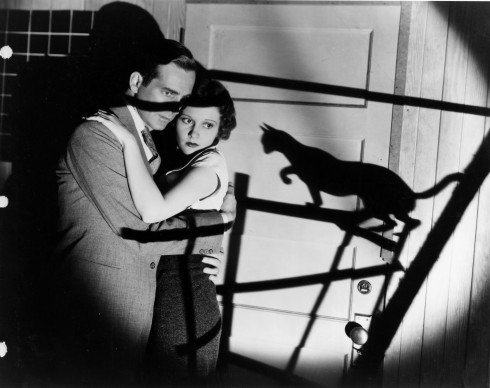 The Black Cat (1934)
The Black Cat (1934)
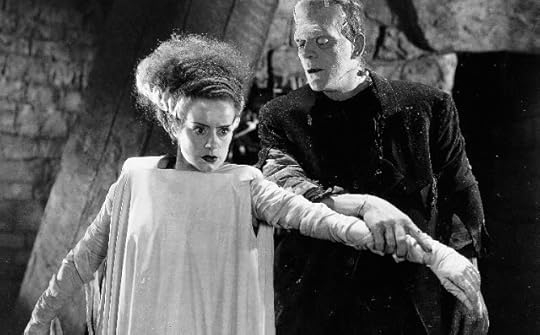 The Bride of Frankenstein (1935)
The Bride of Frankenstein (1935)
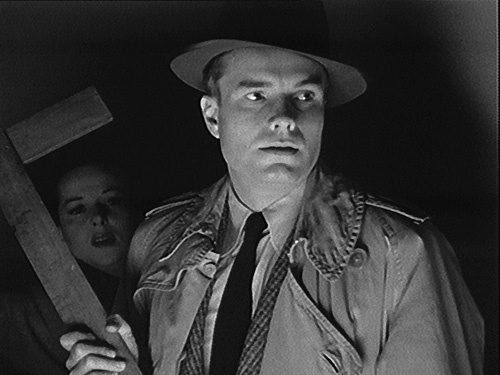 Cat People (1942)
Cat People (1942)
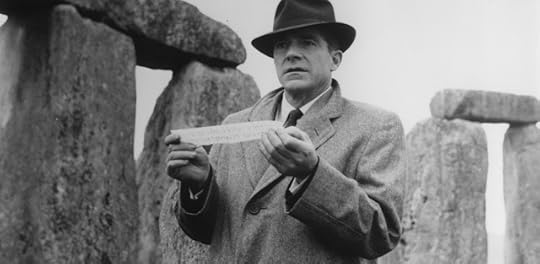 Curse of the Demon/Night of the Demon (1957)
Curse of the Demon/Night of the Demon (1957)
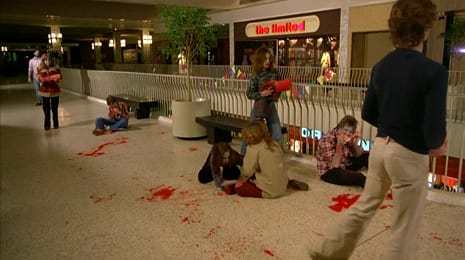 Dawn of the Dead (1978)
Dawn of the Dead (1978)
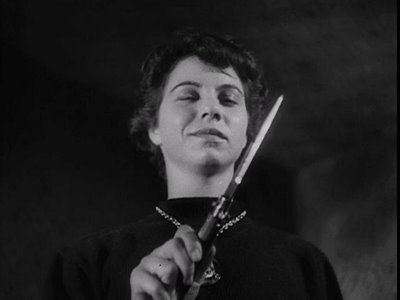 Dementia/Daughter of Horror (1955)
Dementia/Daughter of Horror (1955)
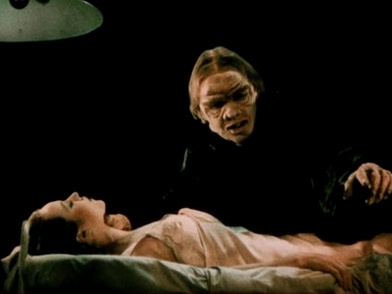 Doctor X (1932)
Doctor X (1932)
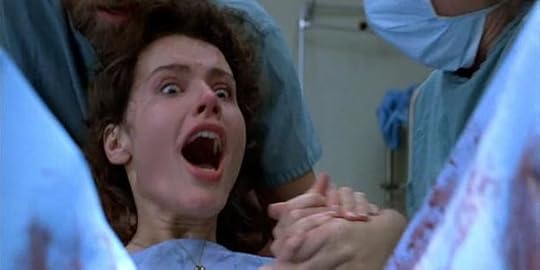 The Fly (1986)
The Fly (1986)
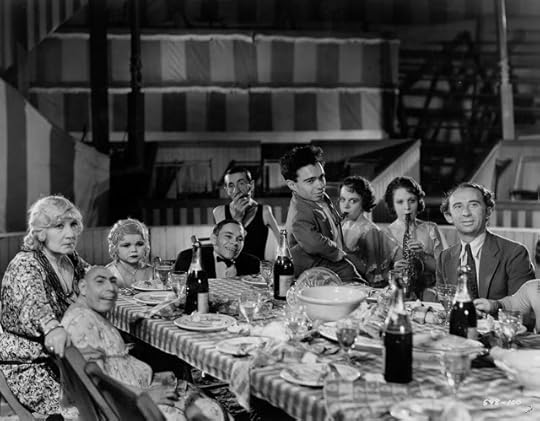 Freaks (1932)
Freaks (1932)
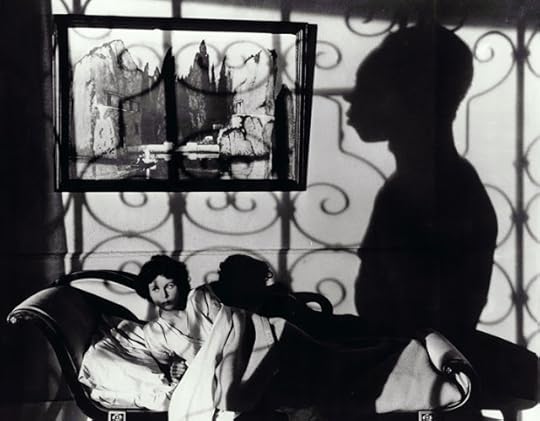 I Walked with a Zombie (1943)
I Walked with a Zombie (1943)
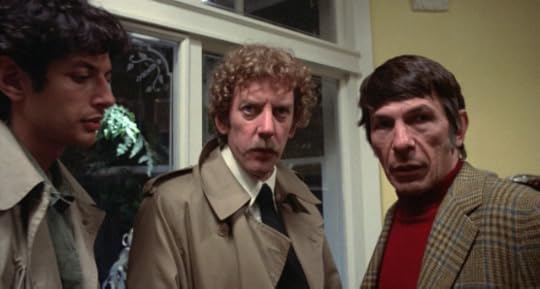 Invasion of the Body Snatchers (1978)
Invasion of the Body Snatchers (1978)
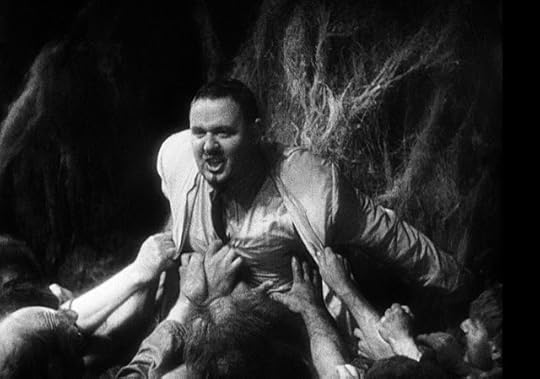 Island of Lost Souls (1932)
Island of Lost Souls (1932)
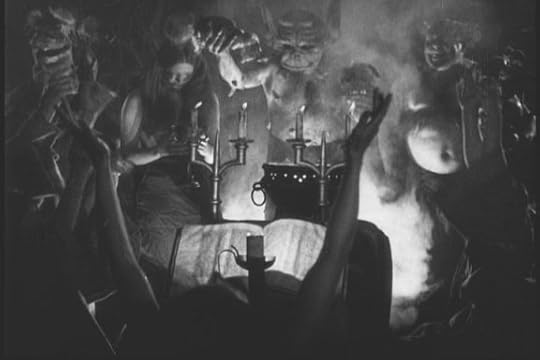 Haxan/Witchcraft Through the Ages (1922)
Haxan/Witchcraft Through the Ages (1922)
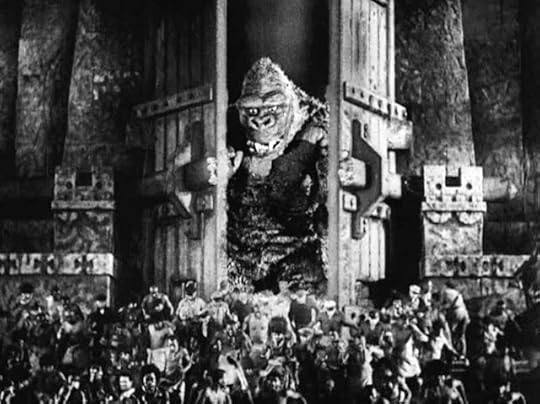 King Kong (1933)
King Kong (1933)
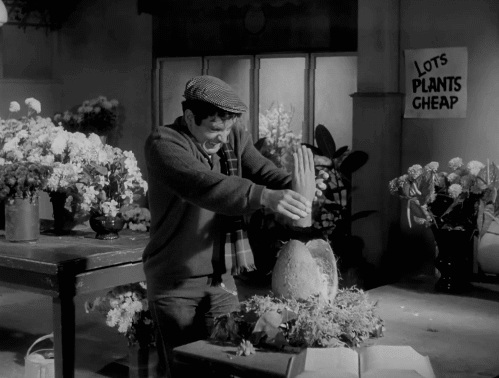 Little Shop of Horrors (1960)
Little Shop of Horrors (1960)
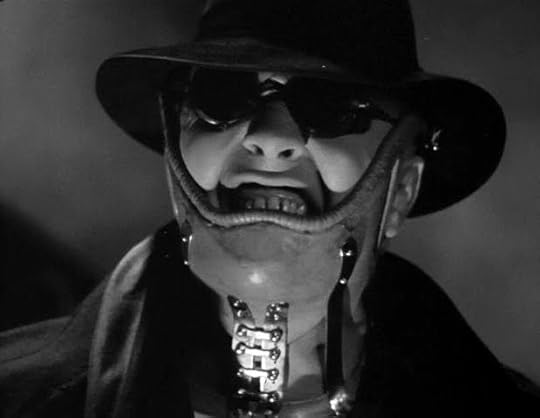 Mad Love (1935)
Mad Love (1935)
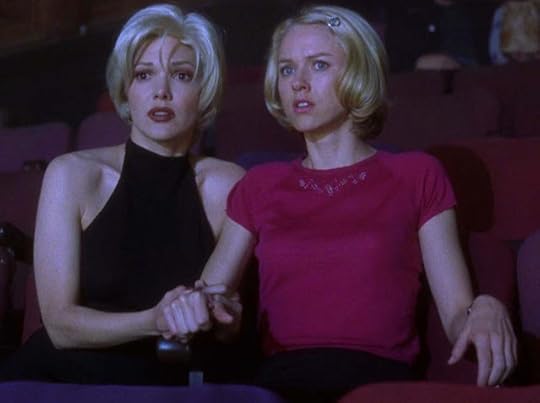 Mulholland Dr. (2001)
Mulholland Dr. (2001)
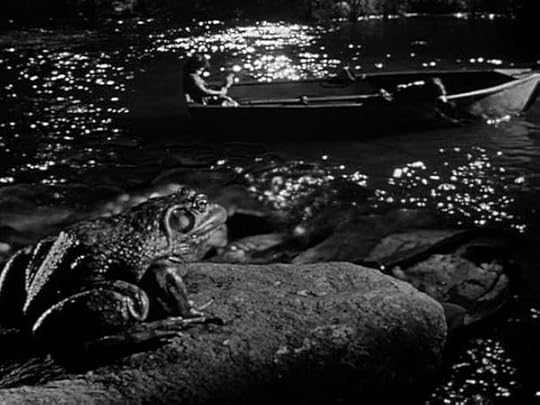 Night of the Hunter (1955)
Night of the Hunter (1955)
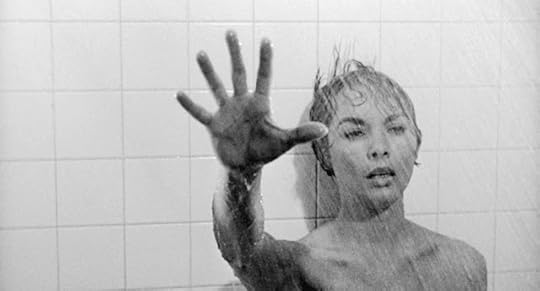 Psycho (1960)
Psycho (1960)
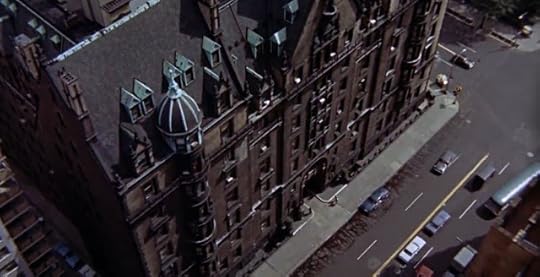 Rosemary's Baby (1968)
Rosemary's Baby (1968)
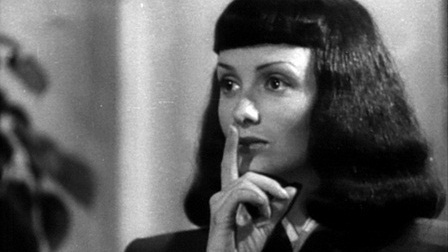 The Seventh Victim (1943)
The Seventh Victim (1943)
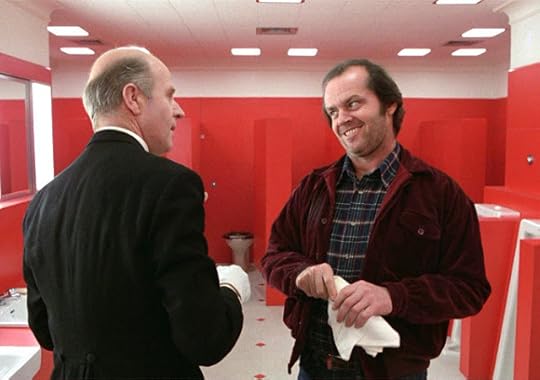 The Shining (1980)
The Shining (1980)
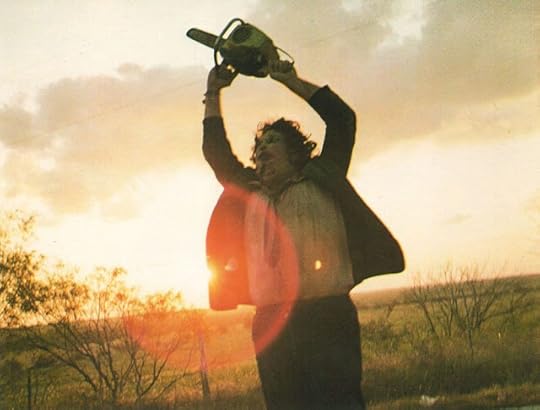 The Texas Chainsaw Massacre (1974)
The Texas Chainsaw Massacre (1974)
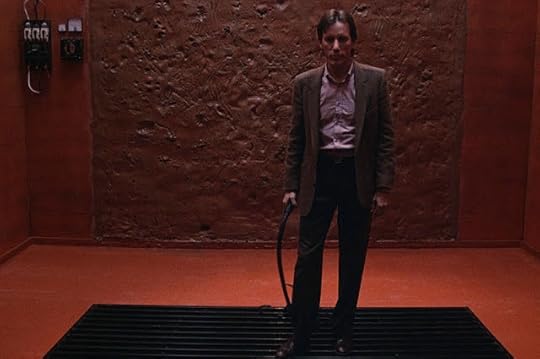 Videodrome (1983)
Videodrome (1983)
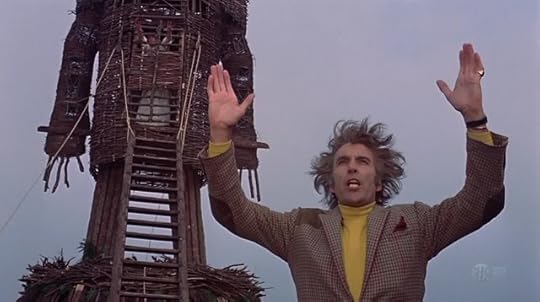 The Wicker Man (1973)
The Wicker Man (1973)
 The Black Cat (1934)
The Black Cat (1934) The Bride of Frankenstein (1935)
The Bride of Frankenstein (1935) Cat People (1942)
Cat People (1942) Curse of the Demon/Night of the Demon (1957)
Curse of the Demon/Night of the Demon (1957) Dawn of the Dead (1978)
Dawn of the Dead (1978) Dementia/Daughter of Horror (1955)
Dementia/Daughter of Horror (1955) Doctor X (1932)
Doctor X (1932) The Fly (1986)
The Fly (1986) Freaks (1932)
Freaks (1932) I Walked with a Zombie (1943)
I Walked with a Zombie (1943) Invasion of the Body Snatchers (1978)
Invasion of the Body Snatchers (1978) Island of Lost Souls (1932)
Island of Lost Souls (1932) Haxan/Witchcraft Through the Ages (1922)
Haxan/Witchcraft Through the Ages (1922) King Kong (1933)
King Kong (1933) Little Shop of Horrors (1960)
Little Shop of Horrors (1960) Mad Love (1935)
Mad Love (1935) Mulholland Dr. (2001)
Mulholland Dr. (2001) Night of the Hunter (1955)
Night of the Hunter (1955) Psycho (1960)
Psycho (1960)  Rosemary's Baby (1968)
Rosemary's Baby (1968) The Seventh Victim (1943)
The Seventh Victim (1943) The Shining (1980)
The Shining (1980) The Texas Chainsaw Massacre (1974)
The Texas Chainsaw Massacre (1974) Videodrome (1983)
Videodrome (1983) The Wicker Man (1973)
The Wicker Man (1973)
Published on October 21, 2017 07:32
October 16, 2017
Movies I Watched in September, Part 1
The month is more than half over, so it's high time I started recapping the movies from last month...
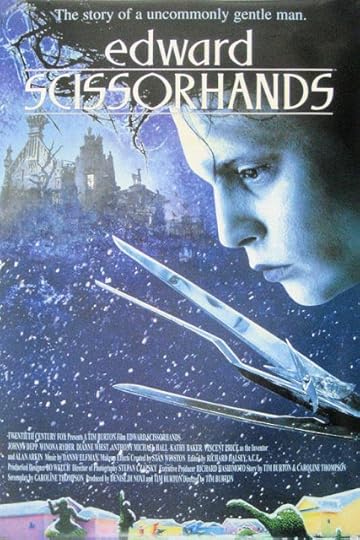 I’ve reached that point in my life where I’m re-watching movies with my daughter that I saw as an adult for the first time in theaters, and though it’ll be awhile before I show her “Ed Wood” (because of the profanity) or “Sweeny Todd” (because of the violence) or “Planet of the Apes” (because it’s terrible), Amy and I figured this 1990 Tim Burton effort would be fine for a 12-year-old. And it was – she seemed to enjoy it, though she kept wondering where Edward got all the ice at the end of the movie. (Good question, Allie!) I don’t think I’d seen the movie in its entirety since I caught it in theaters 27 odd years ago, but it held up pretty well. Johnny Depp, best known back then for “21 Jump Street” and John Waters’ “Cry-Baby” brings the right amount of innocence and pathos without getting too emo, and among the rest of the cast, Dianne Wiest, Kathy Baker and the great Alan Arkin (“Where you off to, Ed?”) are the standouts. As for Winona Ryder, this is right about when she was shedding the wonderful edge she had in “Heathers” and moving into her “prestige” phase, but she’s not bad (except for that awful old lady makeup at the end) and, speaking as a longtime Winona Ryder obsessive, it’s kind of cool seeing her play a blonde cheerleader type. Ooh, mama.
I’ve reached that point in my life where I’m re-watching movies with my daughter that I saw as an adult for the first time in theaters, and though it’ll be awhile before I show her “Ed Wood” (because of the profanity) or “Sweeny Todd” (because of the violence) or “Planet of the Apes” (because it’s terrible), Amy and I figured this 1990 Tim Burton effort would be fine for a 12-year-old. And it was – she seemed to enjoy it, though she kept wondering where Edward got all the ice at the end of the movie. (Good question, Allie!) I don’t think I’d seen the movie in its entirety since I caught it in theaters 27 odd years ago, but it held up pretty well. Johnny Depp, best known back then for “21 Jump Street” and John Waters’ “Cry-Baby” brings the right amount of innocence and pathos without getting too emo, and among the rest of the cast, Dianne Wiest, Kathy Baker and the great Alan Arkin (“Where you off to, Ed?”) are the standouts. As for Winona Ryder, this is right about when she was shedding the wonderful edge she had in “Heathers” and moving into her “prestige” phase, but she’s not bad (except for that awful old lady makeup at the end) and, speaking as a longtime Winona Ryder obsessive, it’s kind of cool seeing her play a blonde cheerleader type. Ooh, mama.
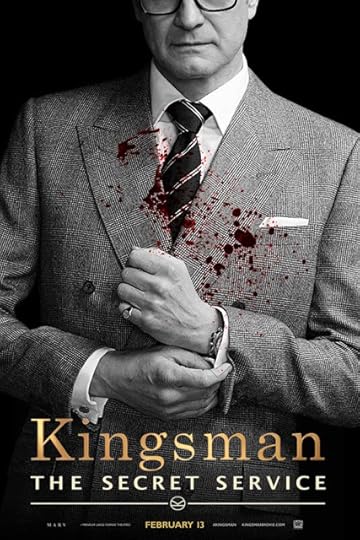
I never read the Mark Millar/Dave Gibbons comic this was based on, but I’ll bet, like “Wanted,” this is a somewhat diluted version of the original. It’s fine, for what it is – a James Bond semi-spoof that wants to update the themes while retaining all the violence and sex of the original model. If anything, it’s a little too slick, with every quick cut and camera angle polished within an inch of its life. Not bad, but not that good, either, and pretty confusing (or at least pretty confused) about the sort of message it’s trying to deliver. (I know a violent Bond pastiche isn’t exactly a message picture, but every movie has a message of some sort, even – especially – this one.) Truth be told, as much fun as it was seeing Colin Firth play an action hero, I kept thinking of him in the much more grounded, much more serious “Tinker, Tailor, Soldier, Spy,” and wished I was watching that instead.
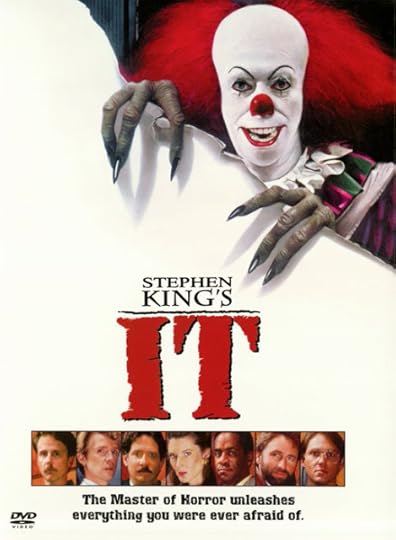 This was the 1990 mini-series, not the 2017 movie, and boy, is it awful. I realize it’s one of those artifacts of the past that people of a certain age love for some odd reason (and I realize I do this with all sorts of old pop culture), but really, this is a bad, bad show. It’s not scary, it’s not suspenseful, and it’s definitely not worth enduring four hours of. The part with the kids is marginally more entertaining, partly because Tim Curry’s Pennywise (the only semi-good thing in the whole mini-series) is a bit scarier during those segments, but mostly because the adult actors – especially Harry Anderson of “Night Court” fame – are virtually unwatchable. I haven’t seen the new movie, so I can’t judge it, but it has to be better than this atrocity. A lot better.
This was the 1990 mini-series, not the 2017 movie, and boy, is it awful. I realize it’s one of those artifacts of the past that people of a certain age love for some odd reason (and I realize I do this with all sorts of old pop culture), but really, this is a bad, bad show. It’s not scary, it’s not suspenseful, and it’s definitely not worth enduring four hours of. The part with the kids is marginally more entertaining, partly because Tim Curry’s Pennywise (the only semi-good thing in the whole mini-series) is a bit scarier during those segments, but mostly because the adult actors – especially Harry Anderson of “Night Court” fame – are virtually unwatchable. I haven’t seen the new movie, so I can’t judge it, but it has to be better than this atrocity. A lot better.
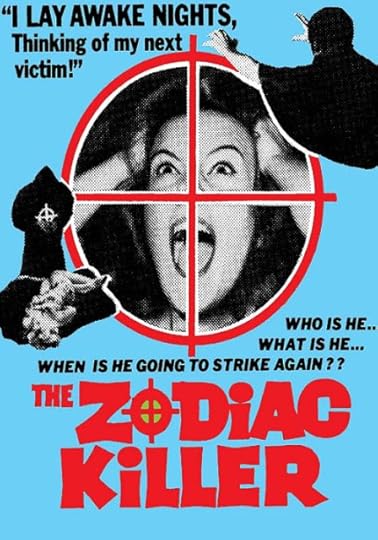
In case you were worried that the September film selections were a little too mainstream, here’s a genuine celluloid oddity to mix things up a bit. Release in 1971, in the midst of the Zodiac murders, this trashy (but fascinating) no-budget wonder was designed to, theoretically, drive the killer out of hiding and into the theater to watch a movie based on his exploits. Director Tom Hanson actually rented out San Francisco’s Golden Gate Theater and offered a Kawasaki motorcycle as a prize for the essay contest “I Believe the Zodiac Kills Because…,” the intention being to get handwriting samples; the assumption being one of them would be from the killer, whom they would then arrest in the lobby. Spoiler alert: It didn’t work. As for the movie itself, it’s a cheap, grimy semi-factual look at the murders, with two fictional suspects offered up and one of them cheerfully walking the streets as the credits roll. Your appreciation for “The Zodiac Killer” will depend on your tolerance for rambling plots, fake violence and shoddy filmmaking, but I found the damned thing oddly mesmerizing. If nothing else, it’s a fascinating artifact and a grim portrait of San Francisco, circa 1971. I sure wish David Fincher had found a way to include the story behind this movie in his masterful, genuinely mesmerizing “Zodiac.”
 I’ve reached that point in my life where I’m re-watching movies with my daughter that I saw as an adult for the first time in theaters, and though it’ll be awhile before I show her “Ed Wood” (because of the profanity) or “Sweeny Todd” (because of the violence) or “Planet of the Apes” (because it’s terrible), Amy and I figured this 1990 Tim Burton effort would be fine for a 12-year-old. And it was – she seemed to enjoy it, though she kept wondering where Edward got all the ice at the end of the movie. (Good question, Allie!) I don’t think I’d seen the movie in its entirety since I caught it in theaters 27 odd years ago, but it held up pretty well. Johnny Depp, best known back then for “21 Jump Street” and John Waters’ “Cry-Baby” brings the right amount of innocence and pathos without getting too emo, and among the rest of the cast, Dianne Wiest, Kathy Baker and the great Alan Arkin (“Where you off to, Ed?”) are the standouts. As for Winona Ryder, this is right about when she was shedding the wonderful edge she had in “Heathers” and moving into her “prestige” phase, but she’s not bad (except for that awful old lady makeup at the end) and, speaking as a longtime Winona Ryder obsessive, it’s kind of cool seeing her play a blonde cheerleader type. Ooh, mama.
I’ve reached that point in my life where I’m re-watching movies with my daughter that I saw as an adult for the first time in theaters, and though it’ll be awhile before I show her “Ed Wood” (because of the profanity) or “Sweeny Todd” (because of the violence) or “Planet of the Apes” (because it’s terrible), Amy and I figured this 1990 Tim Burton effort would be fine for a 12-year-old. And it was – she seemed to enjoy it, though she kept wondering where Edward got all the ice at the end of the movie. (Good question, Allie!) I don’t think I’d seen the movie in its entirety since I caught it in theaters 27 odd years ago, but it held up pretty well. Johnny Depp, best known back then for “21 Jump Street” and John Waters’ “Cry-Baby” brings the right amount of innocence and pathos without getting too emo, and among the rest of the cast, Dianne Wiest, Kathy Baker and the great Alan Arkin (“Where you off to, Ed?”) are the standouts. As for Winona Ryder, this is right about when she was shedding the wonderful edge she had in “Heathers” and moving into her “prestige” phase, but she’s not bad (except for that awful old lady makeup at the end) and, speaking as a longtime Winona Ryder obsessive, it’s kind of cool seeing her play a blonde cheerleader type. Ooh, mama.
I never read the Mark Millar/Dave Gibbons comic this was based on, but I’ll bet, like “Wanted,” this is a somewhat diluted version of the original. It’s fine, for what it is – a James Bond semi-spoof that wants to update the themes while retaining all the violence and sex of the original model. If anything, it’s a little too slick, with every quick cut and camera angle polished within an inch of its life. Not bad, but not that good, either, and pretty confusing (or at least pretty confused) about the sort of message it’s trying to deliver. (I know a violent Bond pastiche isn’t exactly a message picture, but every movie has a message of some sort, even – especially – this one.) Truth be told, as much fun as it was seeing Colin Firth play an action hero, I kept thinking of him in the much more grounded, much more serious “Tinker, Tailor, Soldier, Spy,” and wished I was watching that instead.
 This was the 1990 mini-series, not the 2017 movie, and boy, is it awful. I realize it’s one of those artifacts of the past that people of a certain age love for some odd reason (and I realize I do this with all sorts of old pop culture), but really, this is a bad, bad show. It’s not scary, it’s not suspenseful, and it’s definitely not worth enduring four hours of. The part with the kids is marginally more entertaining, partly because Tim Curry’s Pennywise (the only semi-good thing in the whole mini-series) is a bit scarier during those segments, but mostly because the adult actors – especially Harry Anderson of “Night Court” fame – are virtually unwatchable. I haven’t seen the new movie, so I can’t judge it, but it has to be better than this atrocity. A lot better.
This was the 1990 mini-series, not the 2017 movie, and boy, is it awful. I realize it’s one of those artifacts of the past that people of a certain age love for some odd reason (and I realize I do this with all sorts of old pop culture), but really, this is a bad, bad show. It’s not scary, it’s not suspenseful, and it’s definitely not worth enduring four hours of. The part with the kids is marginally more entertaining, partly because Tim Curry’s Pennywise (the only semi-good thing in the whole mini-series) is a bit scarier during those segments, but mostly because the adult actors – especially Harry Anderson of “Night Court” fame – are virtually unwatchable. I haven’t seen the new movie, so I can’t judge it, but it has to be better than this atrocity. A lot better.
In case you were worried that the September film selections were a little too mainstream, here’s a genuine celluloid oddity to mix things up a bit. Release in 1971, in the midst of the Zodiac murders, this trashy (but fascinating) no-budget wonder was designed to, theoretically, drive the killer out of hiding and into the theater to watch a movie based on his exploits. Director Tom Hanson actually rented out San Francisco’s Golden Gate Theater and offered a Kawasaki motorcycle as a prize for the essay contest “I Believe the Zodiac Kills Because…,” the intention being to get handwriting samples; the assumption being one of them would be from the killer, whom they would then arrest in the lobby. Spoiler alert: It didn’t work. As for the movie itself, it’s a cheap, grimy semi-factual look at the murders, with two fictional suspects offered up and one of them cheerfully walking the streets as the credits roll. Your appreciation for “The Zodiac Killer” will depend on your tolerance for rambling plots, fake violence and shoddy filmmaking, but I found the damned thing oddly mesmerizing. If nothing else, it’s a fascinating artifact and a grim portrait of San Francisco, circa 1971. I sure wish David Fincher had found a way to include the story behind this movie in his masterful, genuinely mesmerizing “Zodiac.”
Published on October 16, 2017 19:57
October 4, 2017
The 10 Greatest Stories from MAD's Comic Book era
Harvey Kurtzman's birthday was yesterday, and Will Elder's was a couple of weeks ago, so it felt like the right time to salute what may be the single greatest comic book series ever published, the comic book version of MAD. Here then are my 10 favorite stories from those first 23 glorious issues...
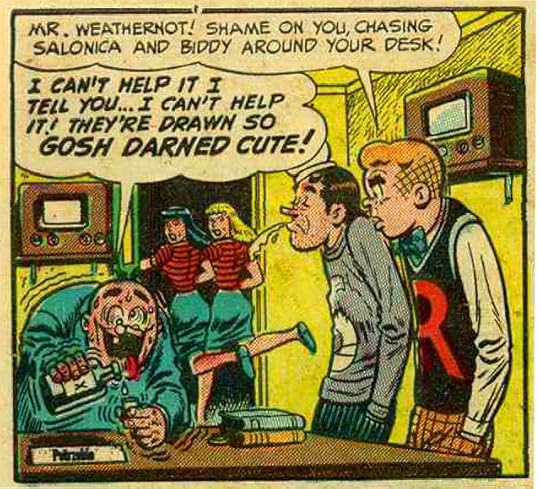 STARCHIE!I posted a panel of this on my Facebook page in honor of Will Elder's birthday (Sept. 22), and I was reminded once again just how goddamn brilliant it is. When I first saw this as a kid in the pages of a Mad Super-Special reprint back in the 1970s, I was genuinely unnerved by how brutal the satire was and how Will Elder twisted the friendly, open lines of the Archie house style into something much deeper and darker. In the years since then, I've read it hundreds of times and have come to the conclusion that it's quite possibly the greatest single comic book story ever published. There. I said it.
STARCHIE!I posted a panel of this on my Facebook page in honor of Will Elder's birthday (Sept. 22), and I was reminded once again just how goddamn brilliant it is. When I first saw this as a kid in the pages of a Mad Super-Special reprint back in the 1970s, I was genuinely unnerved by how brutal the satire was and how Will Elder twisted the friendly, open lines of the Archie house style into something much deeper and darker. In the years since then, I've read it hundreds of times and have come to the conclusion that it's quite possibly the greatest single comic book story ever published. There. I said it.
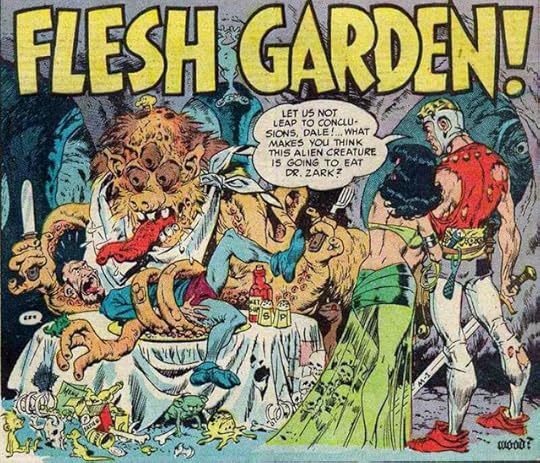 FLESH GARDEN!I'd argue that the great Wally Wood did his greatest work in the pages of Mad, whether in wild (Marie Severin-provided) color in the comic book version or in beautiful black-and-white in the early days of the magazine. Of all his work in Mad, though, I'd pick this crazy, violent take on Alex Raymond's space opera as his all-time best. Every panel is packed, and every line is gorgeously rendered.
FLESH GARDEN!I'd argue that the great Wally Wood did his greatest work in the pages of Mad, whether in wild (Marie Severin-provided) color in the comic book version or in beautiful black-and-white in the early days of the magazine. Of all his work in Mad, though, I'd pick this crazy, violent take on Alex Raymond's space opera as his all-time best. Every panel is packed, and every line is gorgeously rendered.
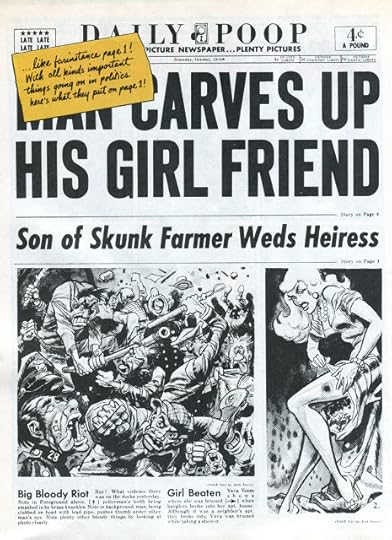 NEWSPAPERS! As the anti-comic book craze of the 1950s was peaking (but before it drove EC out of the comics biz and forced MAD to become a magazine), Kurtzman and Jack Davis unleashed this bold, wild satire of suppression, all under the guise of condemning the terrible influence of newspapers. Presented in the form of "pages" from a typical paper, it proceeds section by section, from the front page (shown above) to the jam-packed back pages of sports, movie ads and other outrageous content. It's a great satire of censorship and public hysteria, sure, but it's also a great example of how many jokes the MAD crew could cram into a single story.
NEWSPAPERS! As the anti-comic book craze of the 1950s was peaking (but before it drove EC out of the comics biz and forced MAD to become a magazine), Kurtzman and Jack Davis unleashed this bold, wild satire of suppression, all under the guise of condemning the terrible influence of newspapers. Presented in the form of "pages" from a typical paper, it proceeds section by section, from the front page (shown above) to the jam-packed back pages of sports, movie ads and other outrageous content. It's a great satire of censorship and public hysteria, sure, but it's also a great example of how many jokes the MAD crew could cram into a single story.
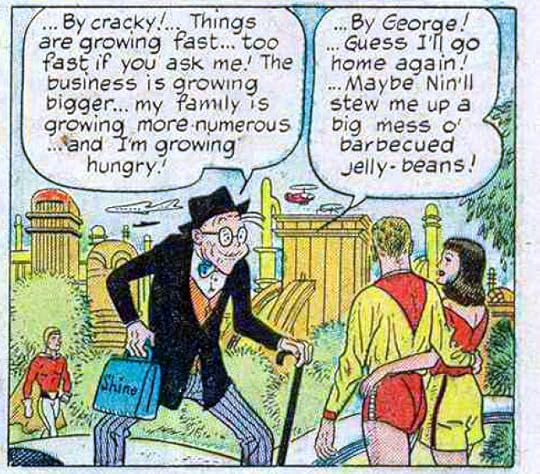 GASOLINE VALLEY!Will Elder was, perhaps, the greatest mimic ever to work in comics, but what really made his art special was the way he could capture another cartoonist's style while adding a subtle, twisted twist. That quality might be best illustrated in this parody of Frank King's classic strip. King legendarily had his characters age in real time, but Kurtzman and Elder compress that concept hilariously, having baby "Skizziks" (spelled backwards is "Skizziks") go from infancy to old age in a few pages. It goes beyond merely funny to downright surreal, but it never loses that gentle, heartwarming King-esque touch.
GASOLINE VALLEY!Will Elder was, perhaps, the greatest mimic ever to work in comics, but what really made his art special was the way he could capture another cartoonist's style while adding a subtle, twisted twist. That quality might be best illustrated in this parody of Frank King's classic strip. King legendarily had his characters age in real time, but Kurtzman and Elder compress that concept hilariously, having baby "Skizziks" (spelled backwards is "Skizziks") go from infancy to old age in a few pages. It goes beyond merely funny to downright surreal, but it never loses that gentle, heartwarming King-esque touch.
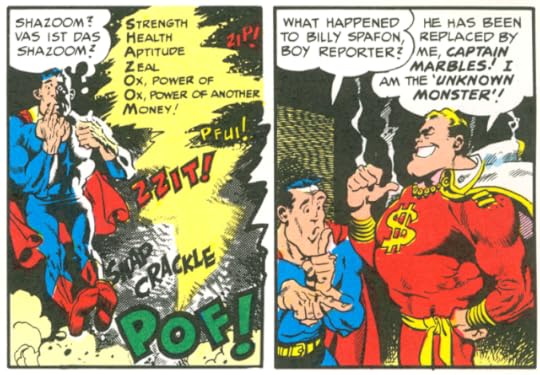 SUPERDUPERMAN! This is arguably the story that really launched the Mad that made history, a dark, smart satire on a specific target that took no prisoners and established Harvey Kurtzman as one of the all-time greats and Wally Wood as someone who could deliver an acid take on modern comics. It still reads well today, with a brutal portrait of Clark Bent, Lois Pain and the weird sadomasochism at the heart of the Superman mythos. Plus, that "Ox, Power of Another" gag in the first panel above always kills me.
SUPERDUPERMAN! This is arguably the story that really launched the Mad that made history, a dark, smart satire on a specific target that took no prisoners and established Harvey Kurtzman as one of the all-time greats and Wally Wood as someone who could deliver an acid take on modern comics. It still reads well today, with a brutal portrait of Clark Bent, Lois Pain and the weird sadomasochism at the heart of the Superman mythos. Plus, that "Ox, Power of Another" gag in the first panel above always kills me.
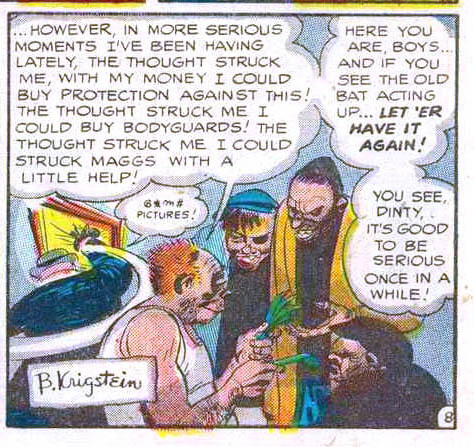 BRINGING BACK FATHER!Less well known than old favorites like "SuperDuperMan!" and "Starchie!," probably because (a) it hasn't been reprinted nearly as many times and (b) the comic strip it's spoofing, George McManus' "Bringing Up Father," has been largely forgotten. That's a shame because it's one of the best pieces ever to appear in MAD, right up there with the others comedy-wise and arguably even better concept-wise. The story alternates between Will Elder's dead-solid-perfect imitation of McManus' art, then shifts every few pages to a grittier, more "serious" style courtesy of Bernie Krigstein. What makes it work is that Kurtzman's script ends each Elder segment with typical, laff-filled bit of comic strip violence, with Krigstein depicting the grim aftermath as the lead character gets more brutally abused and more dangerously angry about it. It all ends with grim justice being served and perhaps the darkest "moral of the story" in comic book history.
BRINGING BACK FATHER!Less well known than old favorites like "SuperDuperMan!" and "Starchie!," probably because (a) it hasn't been reprinted nearly as many times and (b) the comic strip it's spoofing, George McManus' "Bringing Up Father," has been largely forgotten. That's a shame because it's one of the best pieces ever to appear in MAD, right up there with the others comedy-wise and arguably even better concept-wise. The story alternates between Will Elder's dead-solid-perfect imitation of McManus' art, then shifts every few pages to a grittier, more "serious" style courtesy of Bernie Krigstein. What makes it work is that Kurtzman's script ends each Elder segment with typical, laff-filled bit of comic strip violence, with Krigstein depicting the grim aftermath as the lead character gets more brutally abused and more dangerously angry about it. It all ends with grim justice being served and perhaps the darkest "moral of the story" in comic book history.
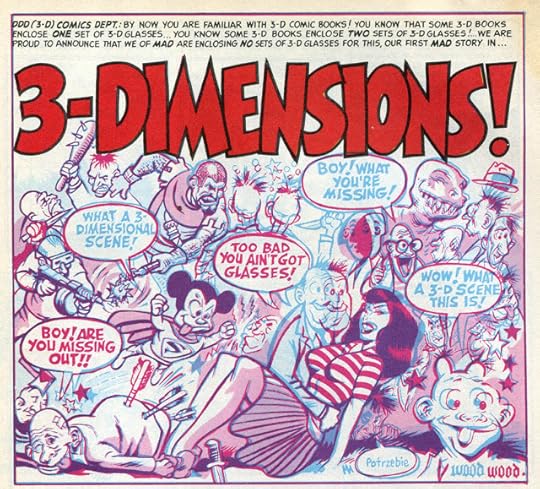 3-DIMENSIONS!
3-DIMENSIONS!
In this brilliant spoof of the (then current) craze in 3-D comics, Kurtzman and Wood take things as far as they can go, then push them even further. The 3-D characters break the fourth wall repeatedly (my favorite bit is when one of them holds up an image of a piece of paper labeled "TOUCH HERE," then explains how, thanks to 3-D, what the reader is touching actually feels (and smells!) like paper). At the end, they tear through the comic itself, revealing a page further in the story, then finally wind up on something I don't think I've ever seen before (or since) in a comic -- a completely blank piece of paper. (I saw the original art for this story at the Masters of Comic Book Art show in Milwaukee back in 2006, and yes, that blank page of comic paper was included.)
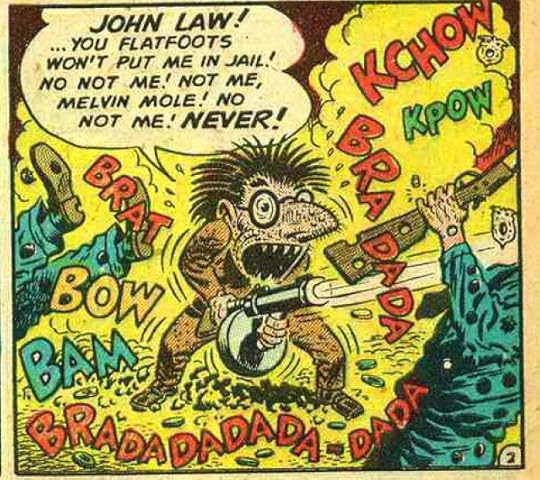 MOLE!One of Will Elder's earliest MAD stories (from issue two) and one of the first vintage MAD stories I remember reading. As a kid, I loved it because it's a simple story with ever-escalating violence (see above) that I found hilarious, and as a grown-up I love it because it's such a beautiful example of Elder's own cartooning style unleashed in a such a maniacal, over-the-top fashion (see also above). Plus there's a sequence at the end with a naked, shaved Mole escaping from prison one last time that never fails to kill me.
MOLE!One of Will Elder's earliest MAD stories (from issue two) and one of the first vintage MAD stories I remember reading. As a kid, I loved it because it's a simple story with ever-escalating violence (see above) that I found hilarious, and as a grown-up I love it because it's such a beautiful example of Elder's own cartooning style unleashed in a such a maniacal, over-the-top fashion (see also above). Plus there's a sequence at the end with a naked, shaved Mole escaping from prison one last time that never fails to kill me.
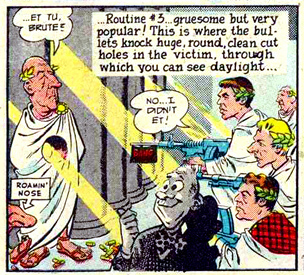 JULIUS CAESAR!One of the densest strips in MAD history (which is really saying something), this Kurtzman-Wood piece begins with a page blasting all the MAD imitations suddenly crowding the comic book rack (including EC's own "authorized imitation," PANIC), then uses a spoof of the 1953 Marlon Brando-starring "Julius Caesar" to illustrate how a satire is done, point by painstaking point. In the end, much like "3-DIMENSIONS!," things go completely insane as our bow-tied narrator pulls off his mask to reveal that he's actually Marilyn Monroe (shown as a photograph) and, what's more, he pulls back the last page of the story to reveal you've actually been reading a Mickey Mouse comic book all along. It's pretty amazing, even more than 50 years later.
JULIUS CAESAR!One of the densest strips in MAD history (which is really saying something), this Kurtzman-Wood piece begins with a page blasting all the MAD imitations suddenly crowding the comic book rack (including EC's own "authorized imitation," PANIC), then uses a spoof of the 1953 Marlon Brando-starring "Julius Caesar" to illustrate how a satire is done, point by painstaking point. In the end, much like "3-DIMENSIONS!," things go completely insane as our bow-tied narrator pulls off his mask to reveal that he's actually Marilyn Monroe (shown as a photograph) and, what's more, he pulls back the last page of the story to reveal you've actually been reading a Mickey Mouse comic book all along. It's pretty amazing, even more than 50 years later.
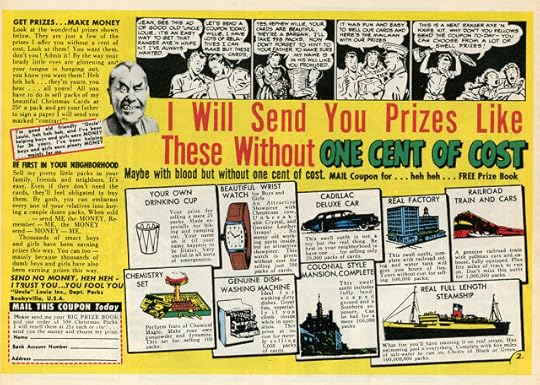 COMIC BOOK ADS!And finally, this is the sort of thing that really blew my mind when I first encountered the comic book version of MAD. Just like in STARCHIE! and GASOLINE VALLEY!, Will Elder's uncanny knack for mimicry recreated a classic comic book element, but with a distinctive, subversive twist. What's different in the case of this feature is that thanks to realistic typesetting and Kurtzman's dense but dead-on prose, they REALLY, REALLY looked like genuine comic book ads, and only when you looked closely and saw, for example, the prizes varied from a drinking cup to a "real full-length steamship" did you realize something was up. The cover of this issue (#21) took things even further, flawlessly duplicating and satirizing an entire Johnson Smith-type ad. I loved that image so much I made it the background of the very blog you're reading right now.
COMIC BOOK ADS!And finally, this is the sort of thing that really blew my mind when I first encountered the comic book version of MAD. Just like in STARCHIE! and GASOLINE VALLEY!, Will Elder's uncanny knack for mimicry recreated a classic comic book element, but with a distinctive, subversive twist. What's different in the case of this feature is that thanks to realistic typesetting and Kurtzman's dense but dead-on prose, they REALLY, REALLY looked like genuine comic book ads, and only when you looked closely and saw, for example, the prizes varied from a drinking cup to a "real full-length steamship" did you realize something was up. The cover of this issue (#21) took things even further, flawlessly duplicating and satirizing an entire Johnson Smith-type ad. I loved that image so much I made it the background of the very blog you're reading right now.
 STARCHIE!I posted a panel of this on my Facebook page in honor of Will Elder's birthday (Sept. 22), and I was reminded once again just how goddamn brilliant it is. When I first saw this as a kid in the pages of a Mad Super-Special reprint back in the 1970s, I was genuinely unnerved by how brutal the satire was and how Will Elder twisted the friendly, open lines of the Archie house style into something much deeper and darker. In the years since then, I've read it hundreds of times and have come to the conclusion that it's quite possibly the greatest single comic book story ever published. There. I said it.
STARCHIE!I posted a panel of this on my Facebook page in honor of Will Elder's birthday (Sept. 22), and I was reminded once again just how goddamn brilliant it is. When I first saw this as a kid in the pages of a Mad Super-Special reprint back in the 1970s, I was genuinely unnerved by how brutal the satire was and how Will Elder twisted the friendly, open lines of the Archie house style into something much deeper and darker. In the years since then, I've read it hundreds of times and have come to the conclusion that it's quite possibly the greatest single comic book story ever published. There. I said it. FLESH GARDEN!I'd argue that the great Wally Wood did his greatest work in the pages of Mad, whether in wild (Marie Severin-provided) color in the comic book version or in beautiful black-and-white in the early days of the magazine. Of all his work in Mad, though, I'd pick this crazy, violent take on Alex Raymond's space opera as his all-time best. Every panel is packed, and every line is gorgeously rendered.
FLESH GARDEN!I'd argue that the great Wally Wood did his greatest work in the pages of Mad, whether in wild (Marie Severin-provided) color in the comic book version or in beautiful black-and-white in the early days of the magazine. Of all his work in Mad, though, I'd pick this crazy, violent take on Alex Raymond's space opera as his all-time best. Every panel is packed, and every line is gorgeously rendered. NEWSPAPERS! As the anti-comic book craze of the 1950s was peaking (but before it drove EC out of the comics biz and forced MAD to become a magazine), Kurtzman and Jack Davis unleashed this bold, wild satire of suppression, all under the guise of condemning the terrible influence of newspapers. Presented in the form of "pages" from a typical paper, it proceeds section by section, from the front page (shown above) to the jam-packed back pages of sports, movie ads and other outrageous content. It's a great satire of censorship and public hysteria, sure, but it's also a great example of how many jokes the MAD crew could cram into a single story.
NEWSPAPERS! As the anti-comic book craze of the 1950s was peaking (but before it drove EC out of the comics biz and forced MAD to become a magazine), Kurtzman and Jack Davis unleashed this bold, wild satire of suppression, all under the guise of condemning the terrible influence of newspapers. Presented in the form of "pages" from a typical paper, it proceeds section by section, from the front page (shown above) to the jam-packed back pages of sports, movie ads and other outrageous content. It's a great satire of censorship and public hysteria, sure, but it's also a great example of how many jokes the MAD crew could cram into a single story. GASOLINE VALLEY!Will Elder was, perhaps, the greatest mimic ever to work in comics, but what really made his art special was the way he could capture another cartoonist's style while adding a subtle, twisted twist. That quality might be best illustrated in this parody of Frank King's classic strip. King legendarily had his characters age in real time, but Kurtzman and Elder compress that concept hilariously, having baby "Skizziks" (spelled backwards is "Skizziks") go from infancy to old age in a few pages. It goes beyond merely funny to downright surreal, but it never loses that gentle, heartwarming King-esque touch.
GASOLINE VALLEY!Will Elder was, perhaps, the greatest mimic ever to work in comics, but what really made his art special was the way he could capture another cartoonist's style while adding a subtle, twisted twist. That quality might be best illustrated in this parody of Frank King's classic strip. King legendarily had his characters age in real time, but Kurtzman and Elder compress that concept hilariously, having baby "Skizziks" (spelled backwards is "Skizziks") go from infancy to old age in a few pages. It goes beyond merely funny to downright surreal, but it never loses that gentle, heartwarming King-esque touch. SUPERDUPERMAN! This is arguably the story that really launched the Mad that made history, a dark, smart satire on a specific target that took no prisoners and established Harvey Kurtzman as one of the all-time greats and Wally Wood as someone who could deliver an acid take on modern comics. It still reads well today, with a brutal portrait of Clark Bent, Lois Pain and the weird sadomasochism at the heart of the Superman mythos. Plus, that "Ox, Power of Another" gag in the first panel above always kills me.
SUPERDUPERMAN! This is arguably the story that really launched the Mad that made history, a dark, smart satire on a specific target that took no prisoners and established Harvey Kurtzman as one of the all-time greats and Wally Wood as someone who could deliver an acid take on modern comics. It still reads well today, with a brutal portrait of Clark Bent, Lois Pain and the weird sadomasochism at the heart of the Superman mythos. Plus, that "Ox, Power of Another" gag in the first panel above always kills me. BRINGING BACK FATHER!Less well known than old favorites like "SuperDuperMan!" and "Starchie!," probably because (a) it hasn't been reprinted nearly as many times and (b) the comic strip it's spoofing, George McManus' "Bringing Up Father," has been largely forgotten. That's a shame because it's one of the best pieces ever to appear in MAD, right up there with the others comedy-wise and arguably even better concept-wise. The story alternates between Will Elder's dead-solid-perfect imitation of McManus' art, then shifts every few pages to a grittier, more "serious" style courtesy of Bernie Krigstein. What makes it work is that Kurtzman's script ends each Elder segment with typical, laff-filled bit of comic strip violence, with Krigstein depicting the grim aftermath as the lead character gets more brutally abused and more dangerously angry about it. It all ends with grim justice being served and perhaps the darkest "moral of the story" in comic book history.
BRINGING BACK FATHER!Less well known than old favorites like "SuperDuperMan!" and "Starchie!," probably because (a) it hasn't been reprinted nearly as many times and (b) the comic strip it's spoofing, George McManus' "Bringing Up Father," has been largely forgotten. That's a shame because it's one of the best pieces ever to appear in MAD, right up there with the others comedy-wise and arguably even better concept-wise. The story alternates between Will Elder's dead-solid-perfect imitation of McManus' art, then shifts every few pages to a grittier, more "serious" style courtesy of Bernie Krigstein. What makes it work is that Kurtzman's script ends each Elder segment with typical, laff-filled bit of comic strip violence, with Krigstein depicting the grim aftermath as the lead character gets more brutally abused and more dangerously angry about it. It all ends with grim justice being served and perhaps the darkest "moral of the story" in comic book history. 3-DIMENSIONS!
3-DIMENSIONS!In this brilliant spoof of the (then current) craze in 3-D comics, Kurtzman and Wood take things as far as they can go, then push them even further. The 3-D characters break the fourth wall repeatedly (my favorite bit is when one of them holds up an image of a piece of paper labeled "TOUCH HERE," then explains how, thanks to 3-D, what the reader is touching actually feels (and smells!) like paper). At the end, they tear through the comic itself, revealing a page further in the story, then finally wind up on something I don't think I've ever seen before (or since) in a comic -- a completely blank piece of paper. (I saw the original art for this story at the Masters of Comic Book Art show in Milwaukee back in 2006, and yes, that blank page of comic paper was included.)
 MOLE!One of Will Elder's earliest MAD stories (from issue two) and one of the first vintage MAD stories I remember reading. As a kid, I loved it because it's a simple story with ever-escalating violence (see above) that I found hilarious, and as a grown-up I love it because it's such a beautiful example of Elder's own cartooning style unleashed in a such a maniacal, over-the-top fashion (see also above). Plus there's a sequence at the end with a naked, shaved Mole escaping from prison one last time that never fails to kill me.
MOLE!One of Will Elder's earliest MAD stories (from issue two) and one of the first vintage MAD stories I remember reading. As a kid, I loved it because it's a simple story with ever-escalating violence (see above) that I found hilarious, and as a grown-up I love it because it's such a beautiful example of Elder's own cartooning style unleashed in a such a maniacal, over-the-top fashion (see also above). Plus there's a sequence at the end with a naked, shaved Mole escaping from prison one last time that never fails to kill me. JULIUS CAESAR!One of the densest strips in MAD history (which is really saying something), this Kurtzman-Wood piece begins with a page blasting all the MAD imitations suddenly crowding the comic book rack (including EC's own "authorized imitation," PANIC), then uses a spoof of the 1953 Marlon Brando-starring "Julius Caesar" to illustrate how a satire is done, point by painstaking point. In the end, much like "3-DIMENSIONS!," things go completely insane as our bow-tied narrator pulls off his mask to reveal that he's actually Marilyn Monroe (shown as a photograph) and, what's more, he pulls back the last page of the story to reveal you've actually been reading a Mickey Mouse comic book all along. It's pretty amazing, even more than 50 years later.
JULIUS CAESAR!One of the densest strips in MAD history (which is really saying something), this Kurtzman-Wood piece begins with a page blasting all the MAD imitations suddenly crowding the comic book rack (including EC's own "authorized imitation," PANIC), then uses a spoof of the 1953 Marlon Brando-starring "Julius Caesar" to illustrate how a satire is done, point by painstaking point. In the end, much like "3-DIMENSIONS!," things go completely insane as our bow-tied narrator pulls off his mask to reveal that he's actually Marilyn Monroe (shown as a photograph) and, what's more, he pulls back the last page of the story to reveal you've actually been reading a Mickey Mouse comic book all along. It's pretty amazing, even more than 50 years later. COMIC BOOK ADS!And finally, this is the sort of thing that really blew my mind when I first encountered the comic book version of MAD. Just like in STARCHIE! and GASOLINE VALLEY!, Will Elder's uncanny knack for mimicry recreated a classic comic book element, but with a distinctive, subversive twist. What's different in the case of this feature is that thanks to realistic typesetting and Kurtzman's dense but dead-on prose, they REALLY, REALLY looked like genuine comic book ads, and only when you looked closely and saw, for example, the prizes varied from a drinking cup to a "real full-length steamship" did you realize something was up. The cover of this issue (#21) took things even further, flawlessly duplicating and satirizing an entire Johnson Smith-type ad. I loved that image so much I made it the background of the very blog you're reading right now.
COMIC BOOK ADS!And finally, this is the sort of thing that really blew my mind when I first encountered the comic book version of MAD. Just like in STARCHIE! and GASOLINE VALLEY!, Will Elder's uncanny knack for mimicry recreated a classic comic book element, but with a distinctive, subversive twist. What's different in the case of this feature is that thanks to realistic typesetting and Kurtzman's dense but dead-on prose, they REALLY, REALLY looked like genuine comic book ads, and only when you looked closely and saw, for example, the prizes varied from a drinking cup to a "real full-length steamship" did you realize something was up. The cover of this issue (#21) took things even further, flawlessly duplicating and satirizing an entire Johnson Smith-type ad. I loved that image so much I made it the background of the very blog you're reading right now.
Published on October 04, 2017 07:39
September 23, 2017
Movies I Watched in August
After a brief flurry of activity on this blog last month, I quickly (and surely) reverted to my usual lazy ways. So here, as the end of September draws near, is the brief recap of movies I watched way back in August. Let's hope I remember them...

I'd seen this movie years ago, but I'd forgotten how good it is. Based on a hit play, it never entirely loses its staginess, but in this case, that's a feature and not a bug. By keeping its theatrical roots, "Dead End" works as both a melodrama and as a portrait of The Way Things Are Today (or at least The Way Things Were in 1937). It's like something Barton Fink might have concocted if he hadn't gotten stuck on that Wallace Beery wrestling picture. And, even though "Dead End" was released in 1937, long after the Production Code began its crackdown on all things salacious and subversive, the movie is surprisingly dark, with prodigal hoodlum "Baby Face" Martin (Bogart) returning to his old stomping grounds only to find out his ex-girlfriend (Claire Trevor) is a VD-ridden prostitute and his mother (Ma Kettle herself, Marjorie Main) wants nothing to do with him. Those are just a few of the notable names in this frankly amazing case, incidentally. You also get Joel McCrea, Sylvia Sidney, Allen Jenkins and Ward Bond, plus the eponymous Dead End kids, who got their name (and fame) from this play/movie and rode it for decades. They're much more rough around the edges here, with future gang leader Leo Gorcey betraying the others and almost getting "the mark of the squealer" -- a slashed face, in other words. The moral of the story? "Snitches get stitches" is far from a modern invention.

So much fun, and I finally found it on Blu-ray. This is really one of the all-time great movies about movies, a celebration by director (and movie fan) Joe Dante of the sort of gleeful promotional nonsense guys like William Castle concocted to put people in the seats. Here he takes the form of Lawrence Woolsey, wonderfully played by John Goodman as the proverbial huckster with a heart of gold. He breezes into a small coastal town during the Cuban Missile Crisis to screen his latest monster movie, "Mant!," and the schlock film, the actual crisis, teenage hormones, faked protests (by John Sayles and Dick Miller!) and a few dozen other elements combine to cause chaos during the premiere showing. It looks great, it has a big heart and it's a lot of fun, especially if you're a movie fan (and if you're not, why are you still reading this). I was left with one question, though: Is John Goodman the single most underrated actor of the modern age? I mean, has he never not delivered a noteworthy performance?

I liked it again upon rewatch, though maybe just a tiny bit less than I did during its theatrical run. (The battle near the end dragged a tad, I'm sorry to say.) Still, what works works beautifully, from the character arc of Rocket (!) to the genuinely touching funeral of a certain character. If you want a more extensive review, here's my original write-up.

I'd read a lot about this movie, mostly in books like "Hollywood Hex" that stressed the fact that this violent take on Shakespeare was the first movie Roman Polanski directed after the Manson murders. I'm not buying that book's premise that the film was "cursed," but it's pretty obvious that Polanksi (not the lightest of filmmakers at his cheeriest) was channeling some pretty dark stuff into this 1971 version of The Scottish Play. It's great, truly great, not just as a Shakespeare adaptation but as a piece of cinema, with Polanski and co-writer Kenneth Tynan putting the insanity and paranoia of the story front and center. Jon Finch and Francesca Annis are surprisingly young for MacBeth and his Lady, but it works beautifully, with their ambition dragging them down paths they barely realize they're on. Polanski turns the whole tale into a grimy, gritty nightmare that feels horribly real, even when it's clearly treading into dark fantasy. There's a surreal dream sequence that manages to top the one in "Rosemary's Baby" (oddly, it also features a crowd of naked old people) and the violence is genuinely brutal, with some unnerving bear baiting at a feast and the final fate of MacBeth (spoilers!) reaching some sort of feverish peak. Thank you, once again, to the fine folks at Criterion for releasing this one on Blu-ray.

I'd seen this movie years ago, but I'd forgotten how good it is. Based on a hit play, it never entirely loses its staginess, but in this case, that's a feature and not a bug. By keeping its theatrical roots, "Dead End" works as both a melodrama and as a portrait of The Way Things Are Today (or at least The Way Things Were in 1937). It's like something Barton Fink might have concocted if he hadn't gotten stuck on that Wallace Beery wrestling picture. And, even though "Dead End" was released in 1937, long after the Production Code began its crackdown on all things salacious and subversive, the movie is surprisingly dark, with prodigal hoodlum "Baby Face" Martin (Bogart) returning to his old stomping grounds only to find out his ex-girlfriend (Claire Trevor) is a VD-ridden prostitute and his mother (Ma Kettle herself, Marjorie Main) wants nothing to do with him. Those are just a few of the notable names in this frankly amazing case, incidentally. You also get Joel McCrea, Sylvia Sidney, Allen Jenkins and Ward Bond, plus the eponymous Dead End kids, who got their name (and fame) from this play/movie and rode it for decades. They're much more rough around the edges here, with future gang leader Leo Gorcey betraying the others and almost getting "the mark of the squealer" -- a slashed face, in other words. The moral of the story? "Snitches get stitches" is far from a modern invention.

So much fun, and I finally found it on Blu-ray. This is really one of the all-time great movies about movies, a celebration by director (and movie fan) Joe Dante of the sort of gleeful promotional nonsense guys like William Castle concocted to put people in the seats. Here he takes the form of Lawrence Woolsey, wonderfully played by John Goodman as the proverbial huckster with a heart of gold. He breezes into a small coastal town during the Cuban Missile Crisis to screen his latest monster movie, "Mant!," and the schlock film, the actual crisis, teenage hormones, faked protests (by John Sayles and Dick Miller!) and a few dozen other elements combine to cause chaos during the premiere showing. It looks great, it has a big heart and it's a lot of fun, especially if you're a movie fan (and if you're not, why are you still reading this). I was left with one question, though: Is John Goodman the single most underrated actor of the modern age? I mean, has he never not delivered a noteworthy performance?

I liked it again upon rewatch, though maybe just a tiny bit less than I did during its theatrical run. (The battle near the end dragged a tad, I'm sorry to say.) Still, what works works beautifully, from the character arc of Rocket (!) to the genuinely touching funeral of a certain character. If you want a more extensive review, here's my original write-up.

I'd read a lot about this movie, mostly in books like "Hollywood Hex" that stressed the fact that this violent take on Shakespeare was the first movie Roman Polanski directed after the Manson murders. I'm not buying that book's premise that the film was "cursed," but it's pretty obvious that Polanksi (not the lightest of filmmakers at his cheeriest) was channeling some pretty dark stuff into this 1971 version of The Scottish Play. It's great, truly great, not just as a Shakespeare adaptation but as a piece of cinema, with Polanski and co-writer Kenneth Tynan putting the insanity and paranoia of the story front and center. Jon Finch and Francesca Annis are surprisingly young for MacBeth and his Lady, but it works beautifully, with their ambition dragging them down paths they barely realize they're on. Polanski turns the whole tale into a grimy, gritty nightmare that feels horribly real, even when it's clearly treading into dark fantasy. There's a surreal dream sequence that manages to top the one in "Rosemary's Baby" (oddly, it also features a crowd of naked old people) and the violence is genuinely brutal, with some unnerving bear baiting at a feast and the final fate of MacBeth (spoilers!) reaching some sort of feverish peak. Thank you, once again, to the fine folks at Criterion for releasing this one on Blu-ray.
Published on September 23, 2017 15:18
Will Pfeifer's Blog
- Will Pfeifer's profile
- 23 followers
Will Pfeifer isn't a Goodreads Author
(yet),
but they
do have a blog,
so here are some recent posts imported from
their feed.



